Communication Theories and Applications
VerifiedAdded on 2020/05/28
|21
|5159
|349
AI Summary
This assignment delves into the realm of communication theories, examining influential models like the Theory of Planned Behavior and the Multifactor Leadership Questionnaire. It explores how these theories are applied to understand phenomena such as employee proactivity, information exchange, and leadership effectiveness. The assignment also touches upon practical applications in areas like workplace training, organizational communication, and media studies.
Contribute Materials
Your contribution can guide someone’s learning journey. Share your
documents today.
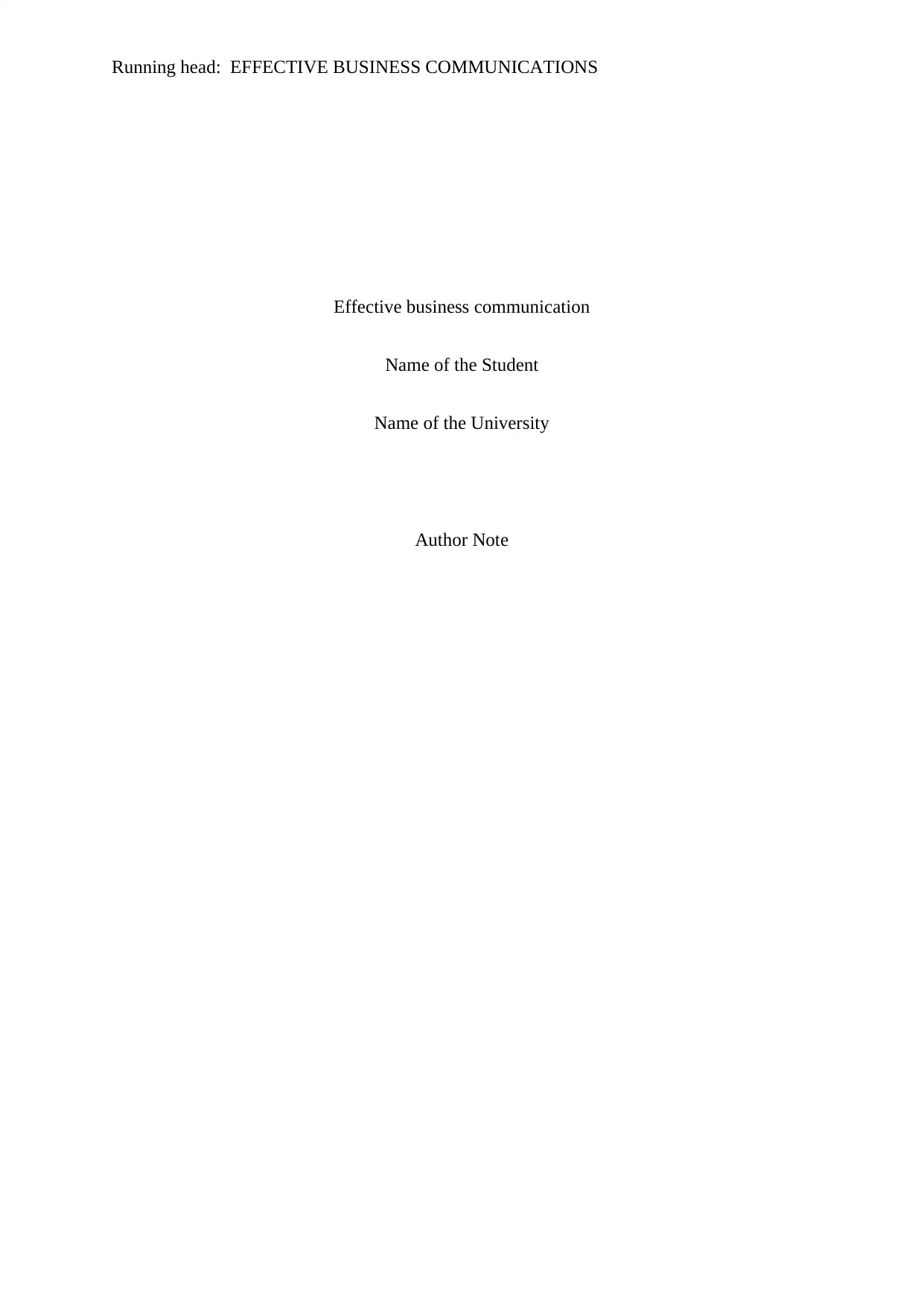
Running head: EFFECTIVE BUSINESS COMMUNICATIONS
Effective business communication
Name of the Student
Name of the University
Author Note
Effective business communication
Name of the Student
Name of the University
Author Note
Secure Best Marks with AI Grader
Need help grading? Try our AI Grader for instant feedback on your assignments.
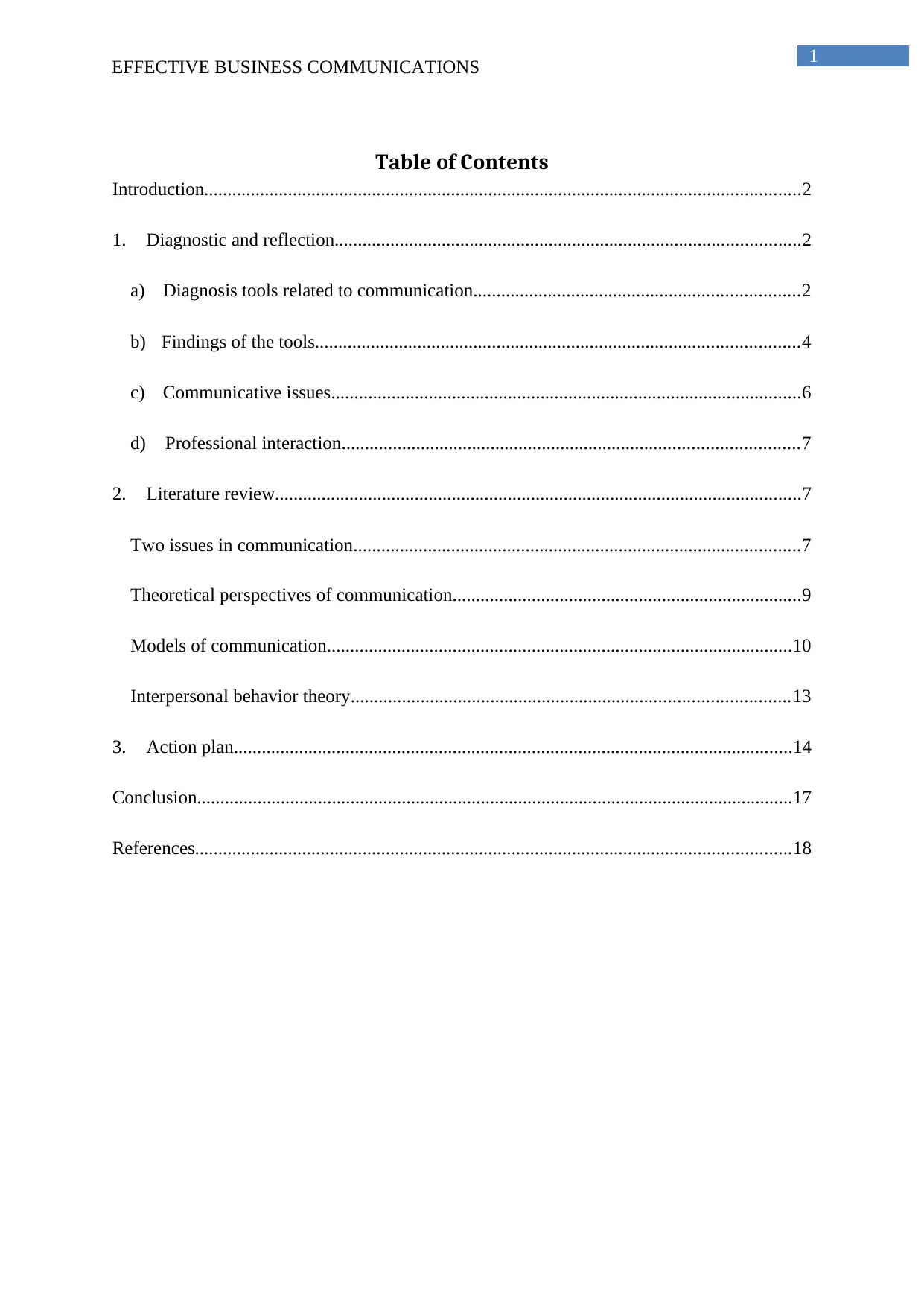
1
EFFECTIVE BUSINESS COMMUNICATIONS
Table of Contents
Introduction................................................................................................................................2
1. Diagnostic and reflection....................................................................................................2
a) Diagnosis tools related to communication......................................................................2
b) Findings of the tools........................................................................................................4
c) Communicative issues.....................................................................................................6
d) Professional interaction..................................................................................................7
2. Literature review.................................................................................................................7
Two issues in communication................................................................................................7
Theoretical perspectives of communication...........................................................................9
Models of communication....................................................................................................10
Interpersonal behavior theory..............................................................................................13
3. Action plan........................................................................................................................14
Conclusion................................................................................................................................17
References................................................................................................................................18
EFFECTIVE BUSINESS COMMUNICATIONS
Table of Contents
Introduction................................................................................................................................2
1. Diagnostic and reflection....................................................................................................2
a) Diagnosis tools related to communication......................................................................2
b) Findings of the tools........................................................................................................4
c) Communicative issues.....................................................................................................6
d) Professional interaction..................................................................................................7
2. Literature review.................................................................................................................7
Two issues in communication................................................................................................7
Theoretical perspectives of communication...........................................................................9
Models of communication....................................................................................................10
Interpersonal behavior theory..............................................................................................13
3. Action plan........................................................................................................................14
Conclusion................................................................................................................................17
References................................................................................................................................18
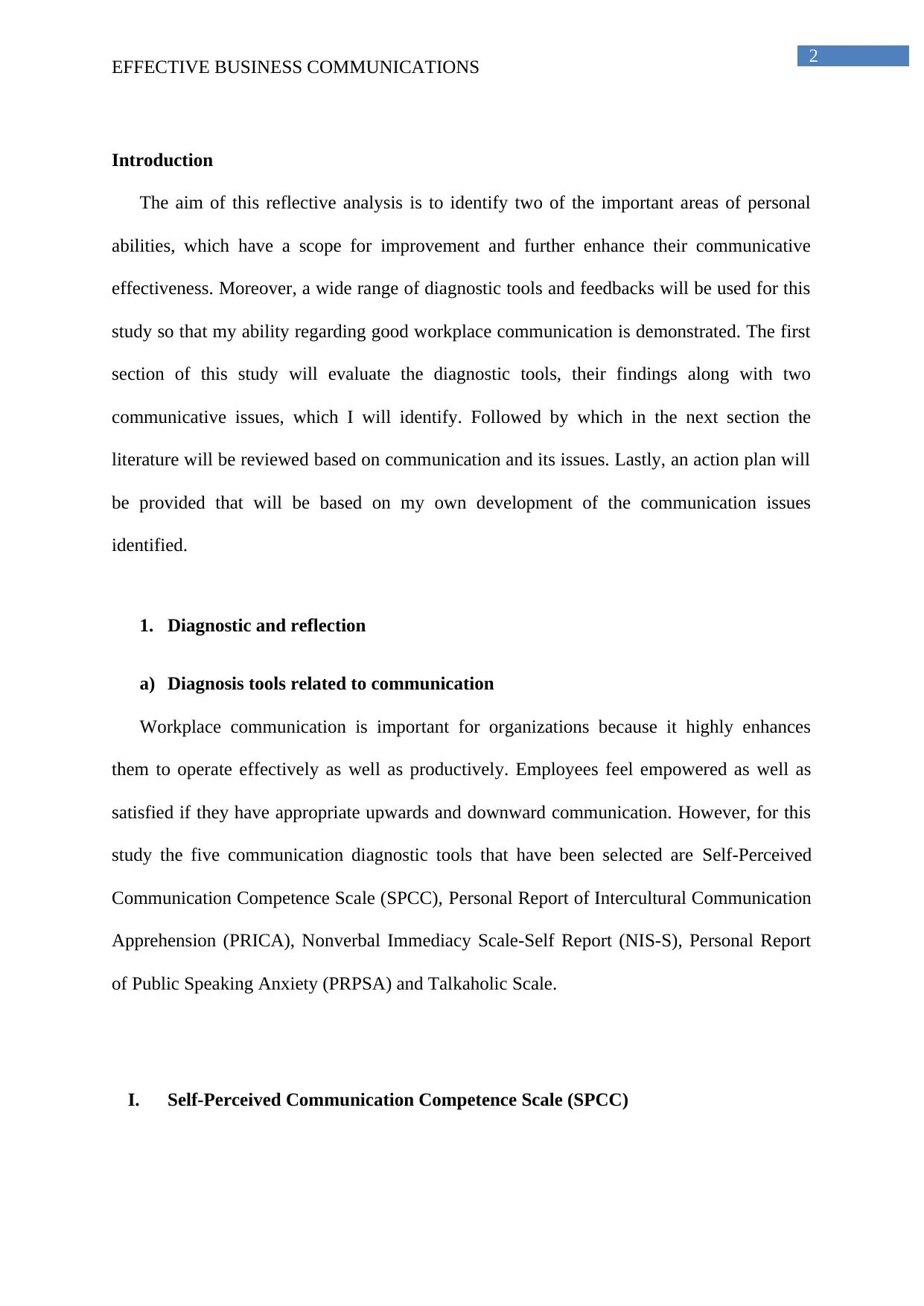
2
EFFECTIVE BUSINESS COMMUNICATIONS
Introduction
The aim of this reflective analysis is to identify two of the important areas of personal
abilities, which have a scope for improvement and further enhance their communicative
effectiveness. Moreover, a wide range of diagnostic tools and feedbacks will be used for this
study so that my ability regarding good workplace communication is demonstrated. The first
section of this study will evaluate the diagnostic tools, their findings along with two
communicative issues, which I will identify. Followed by which in the next section the
literature will be reviewed based on communication and its issues. Lastly, an action plan will
be provided that will be based on my own development of the communication issues
identified.
1. Diagnostic and reflection
a) Diagnosis tools related to communication
Workplace communication is important for organizations because it highly enhances
them to operate effectively as well as productively. Employees feel empowered as well as
satisfied if they have appropriate upwards and downward communication. However, for this
study the five communication diagnostic tools that have been selected are Self-Perceived
Communication Competence Scale (SPCC), Personal Report of Intercultural Communication
Apprehension (PRICA), Nonverbal Immediacy Scale-Self Report (NIS-S), Personal Report
of Public Speaking Anxiety (PRPSA) and Talkaholic Scale.
I. Self-Perceived Communication Competence Scale (SPCC)
EFFECTIVE BUSINESS COMMUNICATIONS
Introduction
The aim of this reflective analysis is to identify two of the important areas of personal
abilities, which have a scope for improvement and further enhance their communicative
effectiveness. Moreover, a wide range of diagnostic tools and feedbacks will be used for this
study so that my ability regarding good workplace communication is demonstrated. The first
section of this study will evaluate the diagnostic tools, their findings along with two
communicative issues, which I will identify. Followed by which in the next section the
literature will be reviewed based on communication and its issues. Lastly, an action plan will
be provided that will be based on my own development of the communication issues
identified.
1. Diagnostic and reflection
a) Diagnosis tools related to communication
Workplace communication is important for organizations because it highly enhances
them to operate effectively as well as productively. Employees feel empowered as well as
satisfied if they have appropriate upwards and downward communication. However, for this
study the five communication diagnostic tools that have been selected are Self-Perceived
Communication Competence Scale (SPCC), Personal Report of Intercultural Communication
Apprehension (PRICA), Nonverbal Immediacy Scale-Self Report (NIS-S), Personal Report
of Public Speaking Anxiety (PRPSA) and Talkaholic Scale.
I. Self-Perceived Communication Competence Scale (SPCC)
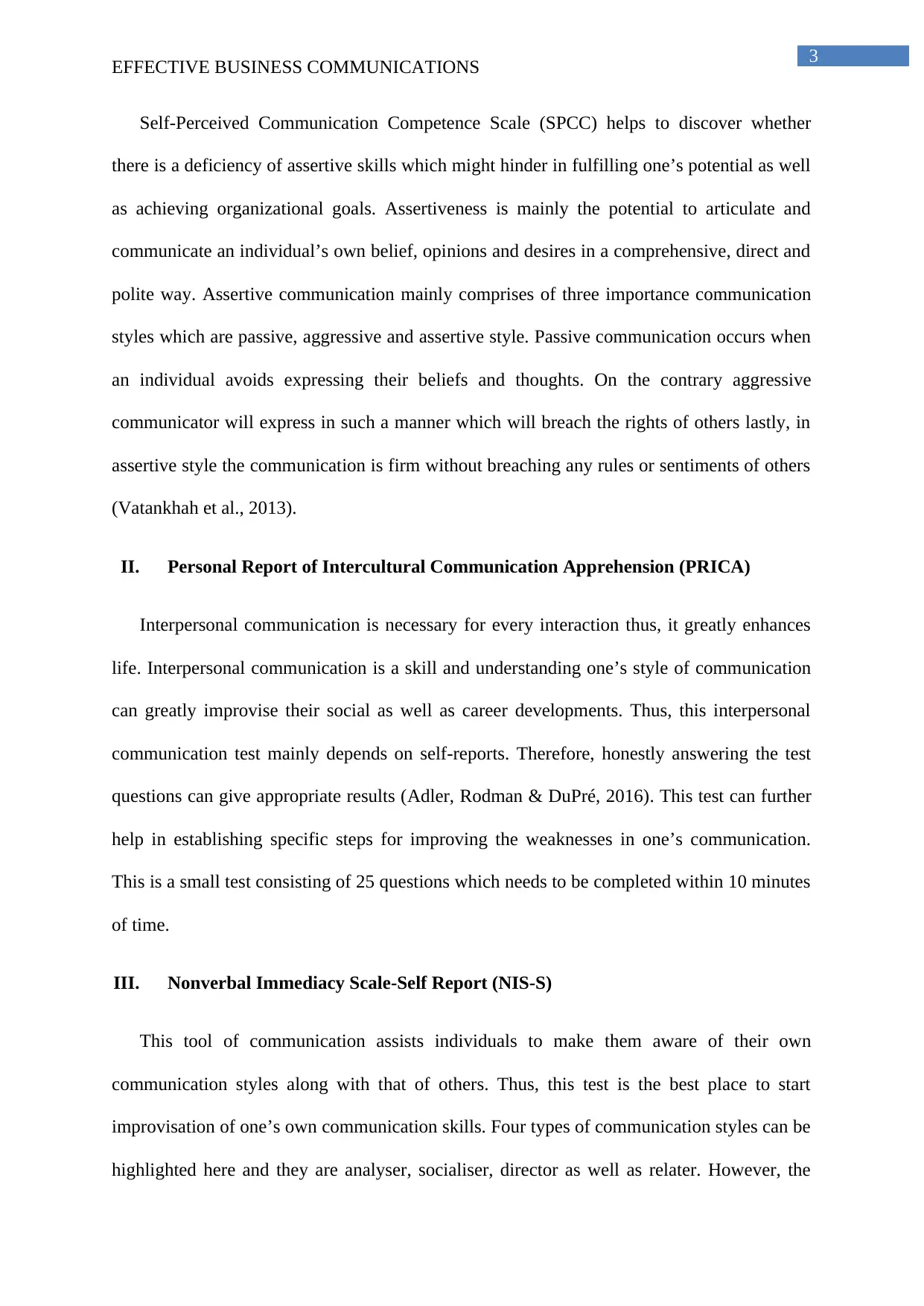
3
EFFECTIVE BUSINESS COMMUNICATIONS
Self-Perceived Communication Competence Scale (SPCC) helps to discover whether
there is a deficiency of assertive skills which might hinder in fulfilling one’s potential as well
as achieving organizational goals. Assertiveness is mainly the potential to articulate and
communicate an individual’s own belief, opinions and desires in a comprehensive, direct and
polite way. Assertive communication mainly comprises of three importance communication
styles which are passive, aggressive and assertive style. Passive communication occurs when
an individual avoids expressing their beliefs and thoughts. On the contrary aggressive
communicator will express in such a manner which will breach the rights of others lastly, in
assertive style the communication is firm without breaching any rules or sentiments of others
(Vatankhah et al., 2013).
II. Personal Report of Intercultural Communication Apprehension (PRICA)
Interpersonal communication is necessary for every interaction thus, it greatly enhances
life. Interpersonal communication is a skill and understanding one’s style of communication
can greatly improvise their social as well as career developments. Thus, this interpersonal
communication test mainly depends on self-reports. Therefore, honestly answering the test
questions can give appropriate results (Adler, Rodman & DuPré, 2016). This test can further
help in establishing specific steps for improving the weaknesses in one’s communication.
This is a small test consisting of 25 questions which needs to be completed within 10 minutes
of time.
III. Nonverbal Immediacy Scale-Self Report (NIS-S)
This tool of communication assists individuals to make them aware of their own
communication styles along with that of others. Thus, this test is the best place to start
improvisation of one’s own communication skills. Four types of communication styles can be
highlighted here and they are analyser, socialiser, director as well as relater. However, the
EFFECTIVE BUSINESS COMMUNICATIONS
Self-Perceived Communication Competence Scale (SPCC) helps to discover whether
there is a deficiency of assertive skills which might hinder in fulfilling one’s potential as well
as achieving organizational goals. Assertiveness is mainly the potential to articulate and
communicate an individual’s own belief, opinions and desires in a comprehensive, direct and
polite way. Assertive communication mainly comprises of three importance communication
styles which are passive, aggressive and assertive style. Passive communication occurs when
an individual avoids expressing their beliefs and thoughts. On the contrary aggressive
communicator will express in such a manner which will breach the rights of others lastly, in
assertive style the communication is firm without breaching any rules or sentiments of others
(Vatankhah et al., 2013).
II. Personal Report of Intercultural Communication Apprehension (PRICA)
Interpersonal communication is necessary for every interaction thus, it greatly enhances
life. Interpersonal communication is a skill and understanding one’s style of communication
can greatly improvise their social as well as career developments. Thus, this interpersonal
communication test mainly depends on self-reports. Therefore, honestly answering the test
questions can give appropriate results (Adler, Rodman & DuPré, 2016). This test can further
help in establishing specific steps for improving the weaknesses in one’s communication.
This is a small test consisting of 25 questions which needs to be completed within 10 minutes
of time.
III. Nonverbal Immediacy Scale-Self Report (NIS-S)
This tool of communication assists individuals to make them aware of their own
communication styles along with that of others. Thus, this test is the best place to start
improvisation of one’s own communication skills. Four types of communication styles can be
highlighted here and they are analyser, socialiser, director as well as relater. However, the
Secure Best Marks with AI Grader
Need help grading? Try our AI Grader for instant feedback on your assignments.
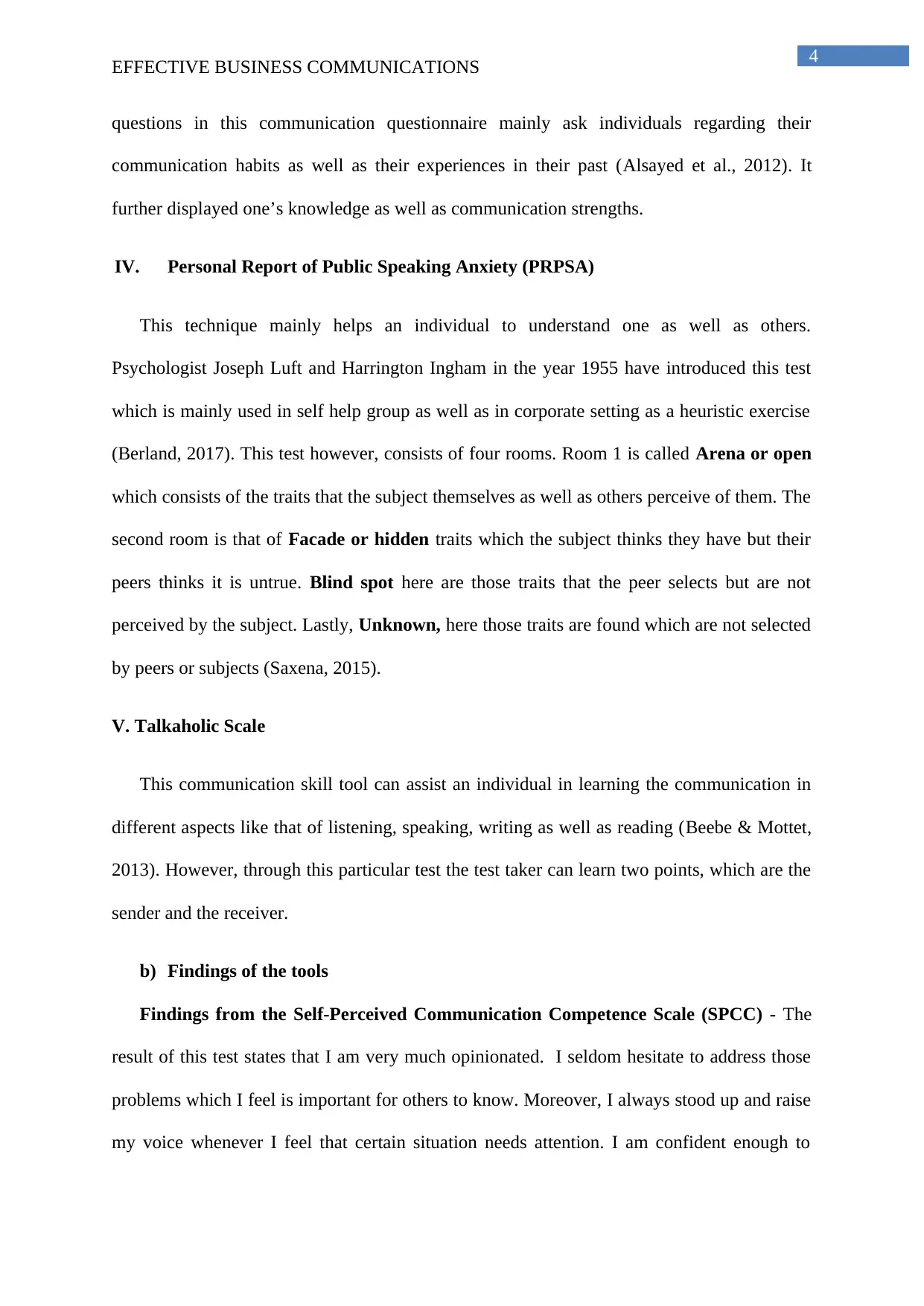
4
EFFECTIVE BUSINESS COMMUNICATIONS
questions in this communication questionnaire mainly ask individuals regarding their
communication habits as well as their experiences in their past (Alsayed et al., 2012). It
further displayed one’s knowledge as well as communication strengths.
IV. Personal Report of Public Speaking Anxiety (PRPSA)
This technique mainly helps an individual to understand one as well as others.
Psychologist Joseph Luft and Harrington Ingham in the year 1955 have introduced this test
which is mainly used in self help group as well as in corporate setting as a heuristic exercise
(Berland, 2017). This test however, consists of four rooms. Room 1 is called Arena or open
which consists of the traits that the subject themselves as well as others perceive of them. The
second room is that of Facade or hidden traits which the subject thinks they have but their
peers thinks it is untrue. Blind spot here are those traits that the peer selects but are not
perceived by the subject. Lastly, Unknown, here those traits are found which are not selected
by peers or subjects (Saxena, 2015).
V. Talkaholic Scale
This communication skill tool can assist an individual in learning the communication in
different aspects like that of listening, speaking, writing as well as reading (Beebe & Mottet,
2013). However, through this particular test the test taker can learn two points, which are the
sender and the receiver.
b) Findings of the tools
Findings from the Self-Perceived Communication Competence Scale (SPCC) - The
result of this test states that I am very much opinionated. I seldom hesitate to address those
problems which I feel is important for others to know. Moreover, I always stood up and raise
my voice whenever I feel that certain situation needs attention. I am confident enough to
EFFECTIVE BUSINESS COMMUNICATIONS
questions in this communication questionnaire mainly ask individuals regarding their
communication habits as well as their experiences in their past (Alsayed et al., 2012). It
further displayed one’s knowledge as well as communication strengths.
IV. Personal Report of Public Speaking Anxiety (PRPSA)
This technique mainly helps an individual to understand one as well as others.
Psychologist Joseph Luft and Harrington Ingham in the year 1955 have introduced this test
which is mainly used in self help group as well as in corporate setting as a heuristic exercise
(Berland, 2017). This test however, consists of four rooms. Room 1 is called Arena or open
which consists of the traits that the subject themselves as well as others perceive of them. The
second room is that of Facade or hidden traits which the subject thinks they have but their
peers thinks it is untrue. Blind spot here are those traits that the peer selects but are not
perceived by the subject. Lastly, Unknown, here those traits are found which are not selected
by peers or subjects (Saxena, 2015).
V. Talkaholic Scale
This communication skill tool can assist an individual in learning the communication in
different aspects like that of listening, speaking, writing as well as reading (Beebe & Mottet,
2013). However, through this particular test the test taker can learn two points, which are the
sender and the receiver.
b) Findings of the tools
Findings from the Self-Perceived Communication Competence Scale (SPCC) - The
result of this test states that I am very much opinionated. I seldom hesitate to address those
problems which I feel is important for others to know. Moreover, I always stood up and raise
my voice whenever I feel that certain situation needs attention. I am confident enough to
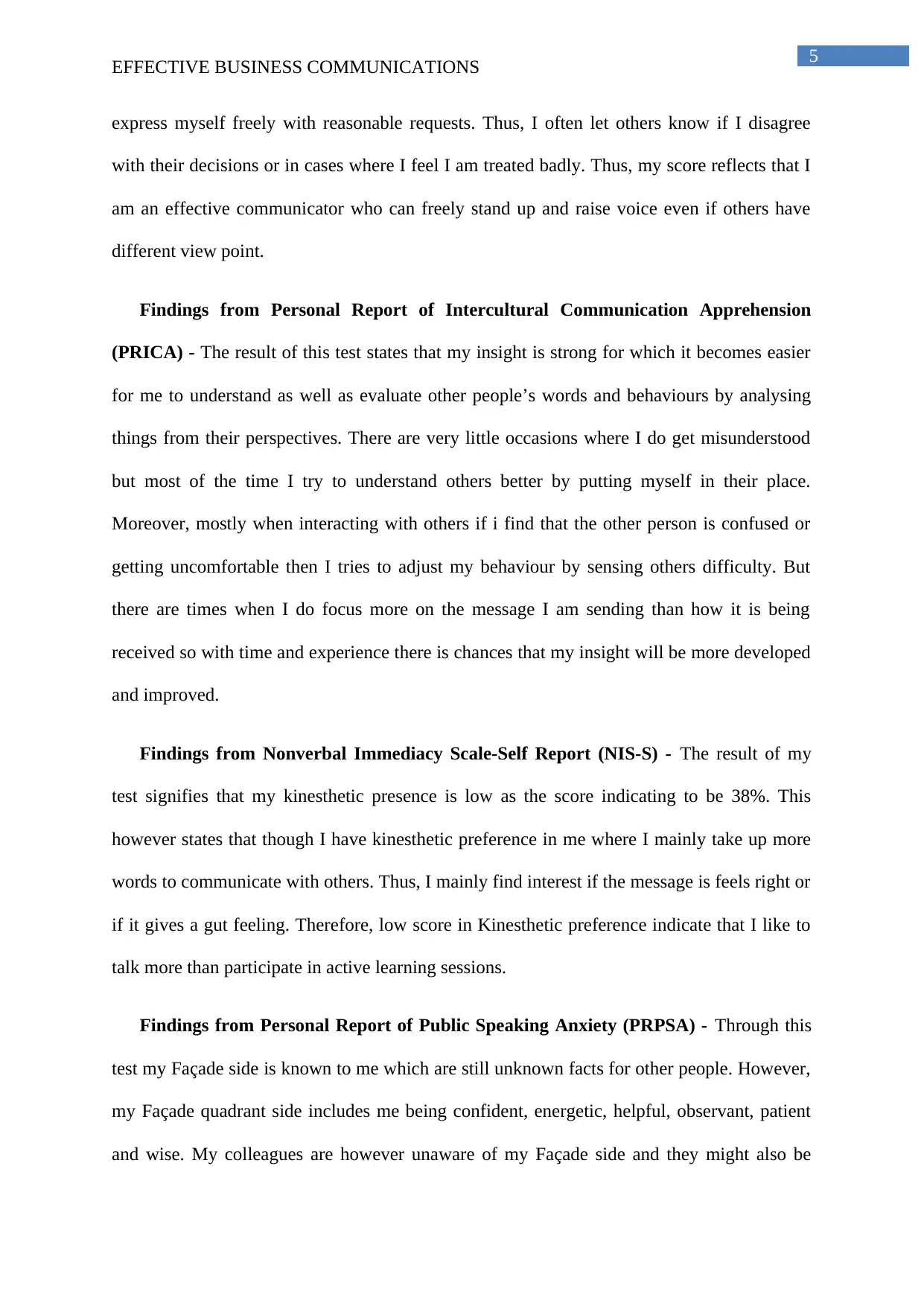
5
EFFECTIVE BUSINESS COMMUNICATIONS
express myself freely with reasonable requests. Thus, I often let others know if I disagree
with their decisions or in cases where I feel I am treated badly. Thus, my score reflects that I
am an effective communicator who can freely stand up and raise voice even if others have
different view point.
Findings from Personal Report of Intercultural Communication Apprehension
(PRICA) - The result of this test states that my insight is strong for which it becomes easier
for me to understand as well as evaluate other people’s words and behaviours by analysing
things from their perspectives. There are very little occasions where I do get misunderstood
but most of the time I try to understand others better by putting myself in their place.
Moreover, mostly when interacting with others if i find that the other person is confused or
getting uncomfortable then I tries to adjust my behaviour by sensing others difficulty. But
there are times when I do focus more on the message I am sending than how it is being
received so with time and experience there is chances that my insight will be more developed
and improved.
Findings from Nonverbal Immediacy Scale-Self Report (NIS-S) - The result of my
test signifies that my kinesthetic presence is low as the score indicating to be 38%. This
however states that though I have kinesthetic preference in me where I mainly take up more
words to communicate with others. Thus, I mainly find interest if the message is feels right or
if it gives a gut feeling. Therefore, low score in Kinesthetic preference indicate that I like to
talk more than participate in active learning sessions.
Findings from Personal Report of Public Speaking Anxiety (PRPSA) - Through this
test my Façade side is known to me which are still unknown facts for other people. However,
my Façade quadrant side includes me being confident, energetic, helpful, observant, patient
and wise. My colleagues are however unaware of my Façade side and they might also be
EFFECTIVE BUSINESS COMMUNICATIONS
express myself freely with reasonable requests. Thus, I often let others know if I disagree
with their decisions or in cases where I feel I am treated badly. Thus, my score reflects that I
am an effective communicator who can freely stand up and raise voice even if others have
different view point.
Findings from Personal Report of Intercultural Communication Apprehension
(PRICA) - The result of this test states that my insight is strong for which it becomes easier
for me to understand as well as evaluate other people’s words and behaviours by analysing
things from their perspectives. There are very little occasions where I do get misunderstood
but most of the time I try to understand others better by putting myself in their place.
Moreover, mostly when interacting with others if i find that the other person is confused or
getting uncomfortable then I tries to adjust my behaviour by sensing others difficulty. But
there are times when I do focus more on the message I am sending than how it is being
received so with time and experience there is chances that my insight will be more developed
and improved.
Findings from Nonverbal Immediacy Scale-Self Report (NIS-S) - The result of my
test signifies that my kinesthetic presence is low as the score indicating to be 38%. This
however states that though I have kinesthetic preference in me where I mainly take up more
words to communicate with others. Thus, I mainly find interest if the message is feels right or
if it gives a gut feeling. Therefore, low score in Kinesthetic preference indicate that I like to
talk more than participate in active learning sessions.
Findings from Personal Report of Public Speaking Anxiety (PRPSA) - Through this
test my Façade side is known to me which are still unknown facts for other people. However,
my Façade quadrant side includes me being confident, energetic, helpful, observant, patient
and wise. My colleagues are however unaware of my Façade side and they might also be
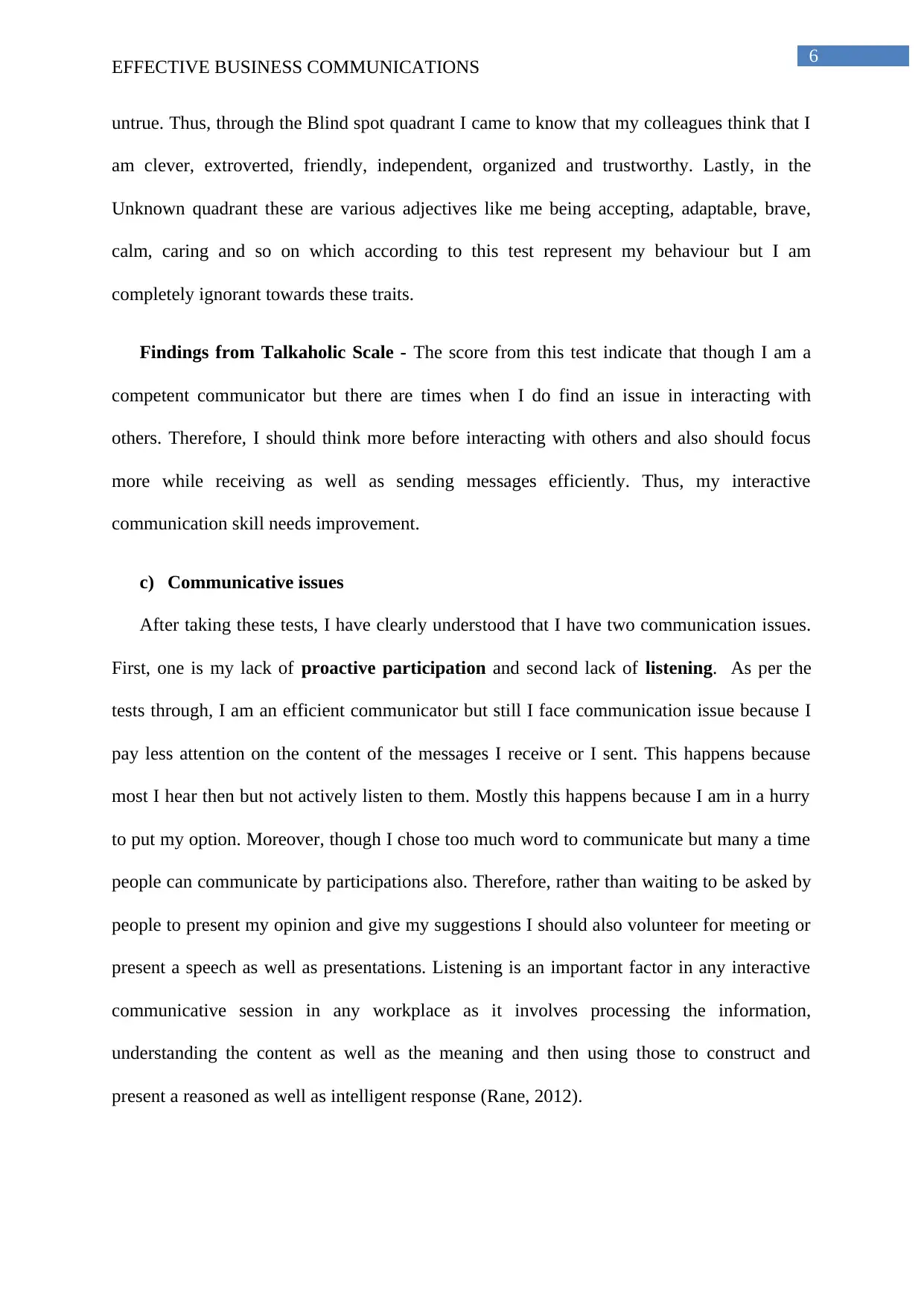
6
EFFECTIVE BUSINESS COMMUNICATIONS
untrue. Thus, through the Blind spot quadrant I came to know that my colleagues think that I
am clever, extroverted, friendly, independent, organized and trustworthy. Lastly, in the
Unknown quadrant these are various adjectives like me being accepting, adaptable, brave,
calm, caring and so on which according to this test represent my behaviour but I am
completely ignorant towards these traits.
Findings from Talkaholic Scale - The score from this test indicate that though I am a
competent communicator but there are times when I do find an issue in interacting with
others. Therefore, I should think more before interacting with others and also should focus
more while receiving as well as sending messages efficiently. Thus, my interactive
communication skill needs improvement.
c) Communicative issues
After taking these tests, I have clearly understood that I have two communication issues.
First, one is my lack of proactive participation and second lack of listening. As per the
tests through, I am an efficient communicator but still I face communication issue because I
pay less attention on the content of the messages I receive or I sent. This happens because
most I hear then but not actively listen to them. Mostly this happens because I am in a hurry
to put my option. Moreover, though I chose too much word to communicate but many a time
people can communicate by participations also. Therefore, rather than waiting to be asked by
people to present my opinion and give my suggestions I should also volunteer for meeting or
present a speech as well as presentations. Listening is an important factor in any interactive
communicative session in any workplace as it involves processing the information,
understanding the content as well as the meaning and then using those to construct and
present a reasoned as well as intelligent response (Rane, 2012).
EFFECTIVE BUSINESS COMMUNICATIONS
untrue. Thus, through the Blind spot quadrant I came to know that my colleagues think that I
am clever, extroverted, friendly, independent, organized and trustworthy. Lastly, in the
Unknown quadrant these are various adjectives like me being accepting, adaptable, brave,
calm, caring and so on which according to this test represent my behaviour but I am
completely ignorant towards these traits.
Findings from Talkaholic Scale - The score from this test indicate that though I am a
competent communicator but there are times when I do find an issue in interacting with
others. Therefore, I should think more before interacting with others and also should focus
more while receiving as well as sending messages efficiently. Thus, my interactive
communication skill needs improvement.
c) Communicative issues
After taking these tests, I have clearly understood that I have two communication issues.
First, one is my lack of proactive participation and second lack of listening. As per the
tests through, I am an efficient communicator but still I face communication issue because I
pay less attention on the content of the messages I receive or I sent. This happens because
most I hear then but not actively listen to them. Mostly this happens because I am in a hurry
to put my option. Moreover, though I chose too much word to communicate but many a time
people can communicate by participations also. Therefore, rather than waiting to be asked by
people to present my opinion and give my suggestions I should also volunteer for meeting or
present a speech as well as presentations. Listening is an important factor in any interactive
communicative session in any workplace as it involves processing the information,
understanding the content as well as the meaning and then using those to construct and
present a reasoned as well as intelligent response (Rane, 2012).
Paraphrase This Document
Need a fresh take? Get an instant paraphrase of this document with our AI Paraphraser
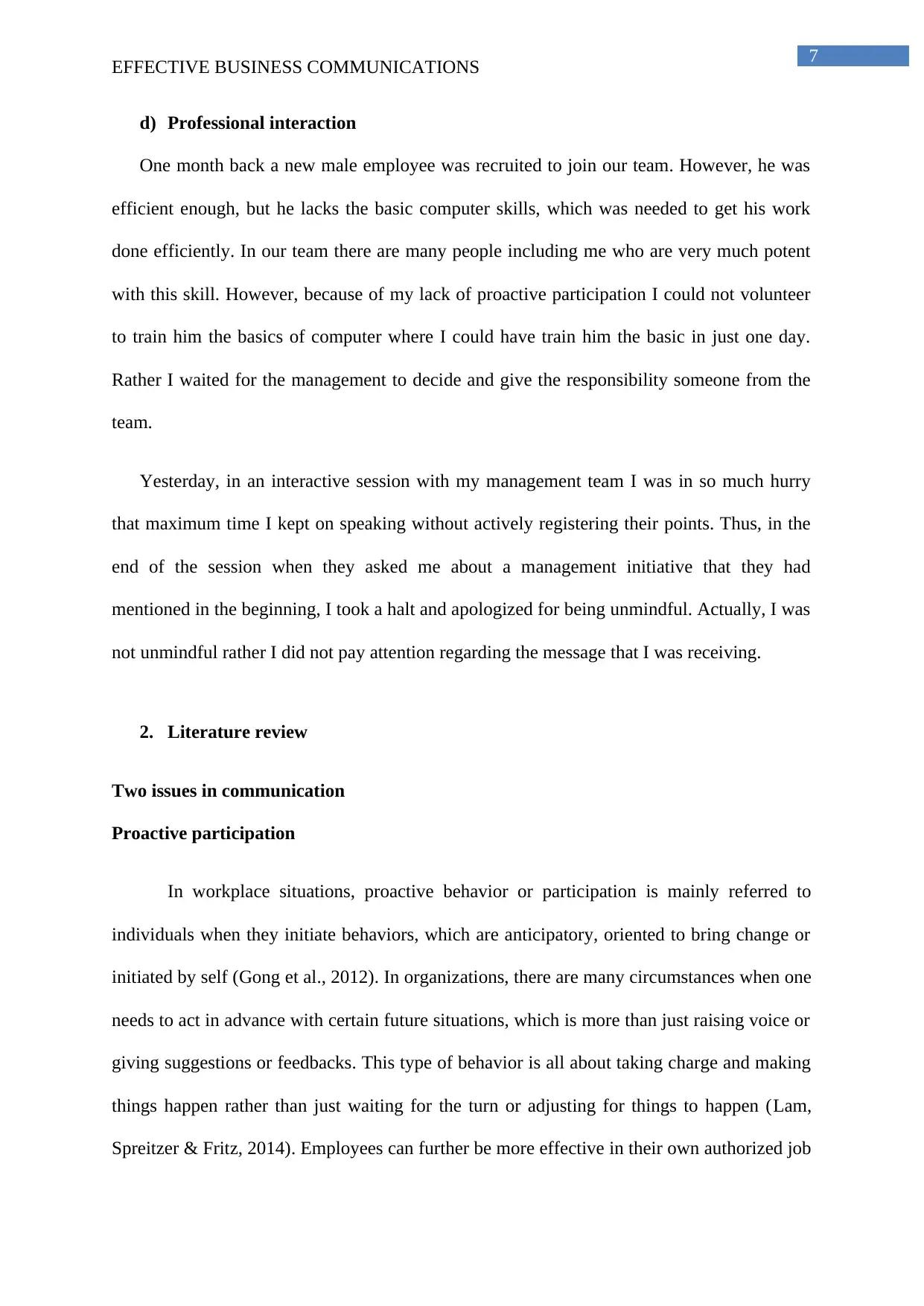
7
EFFECTIVE BUSINESS COMMUNICATIONS
d) Professional interaction
One month back a new male employee was recruited to join our team. However, he was
efficient enough, but he lacks the basic computer skills, which was needed to get his work
done efficiently. In our team there are many people including me who are very much potent
with this skill. However, because of my lack of proactive participation I could not volunteer
to train him the basics of computer where I could have train him the basic in just one day.
Rather I waited for the management to decide and give the responsibility someone from the
team.
Yesterday, in an interactive session with my management team I was in so much hurry
that maximum time I kept on speaking without actively registering their points. Thus, in the
end of the session when they asked me about a management initiative that they had
mentioned in the beginning, I took a halt and apologized for being unmindful. Actually, I was
not unmindful rather I did not pay attention regarding the message that I was receiving.
2. Literature review
Two issues in communication
Proactive participation
In workplace situations, proactive behavior or participation is mainly referred to
individuals when they initiate behaviors, which are anticipatory, oriented to bring change or
initiated by self (Gong et al., 2012). In organizations, there are many circumstances when one
needs to act in advance with certain future situations, which is more than just raising voice or
giving suggestions or feedbacks. This type of behavior is all about taking charge and making
things happen rather than just waiting for the turn or adjusting for things to happen (Lam,
Spreitzer & Fritz, 2014). Employees can further be more effective in their own authorized job
EFFECTIVE BUSINESS COMMUNICATIONS
d) Professional interaction
One month back a new male employee was recruited to join our team. However, he was
efficient enough, but he lacks the basic computer skills, which was needed to get his work
done efficiently. In our team there are many people including me who are very much potent
with this skill. However, because of my lack of proactive participation I could not volunteer
to train him the basics of computer where I could have train him the basic in just one day.
Rather I waited for the management to decide and give the responsibility someone from the
team.
Yesterday, in an interactive session with my management team I was in so much hurry
that maximum time I kept on speaking without actively registering their points. Thus, in the
end of the session when they asked me about a management initiative that they had
mentioned in the beginning, I took a halt and apologized for being unmindful. Actually, I was
not unmindful rather I did not pay attention regarding the message that I was receiving.
2. Literature review
Two issues in communication
Proactive participation
In workplace situations, proactive behavior or participation is mainly referred to
individuals when they initiate behaviors, which are anticipatory, oriented to bring change or
initiated by self (Gong et al., 2012). In organizations, there are many circumstances when one
needs to act in advance with certain future situations, which is more than just raising voice or
giving suggestions or feedbacks. This type of behavior is all about taking charge and making
things happen rather than just waiting for the turn or adjusting for things to happen (Lam,
Spreitzer & Fritz, 2014). Employees can further be more effective in their own authorized job
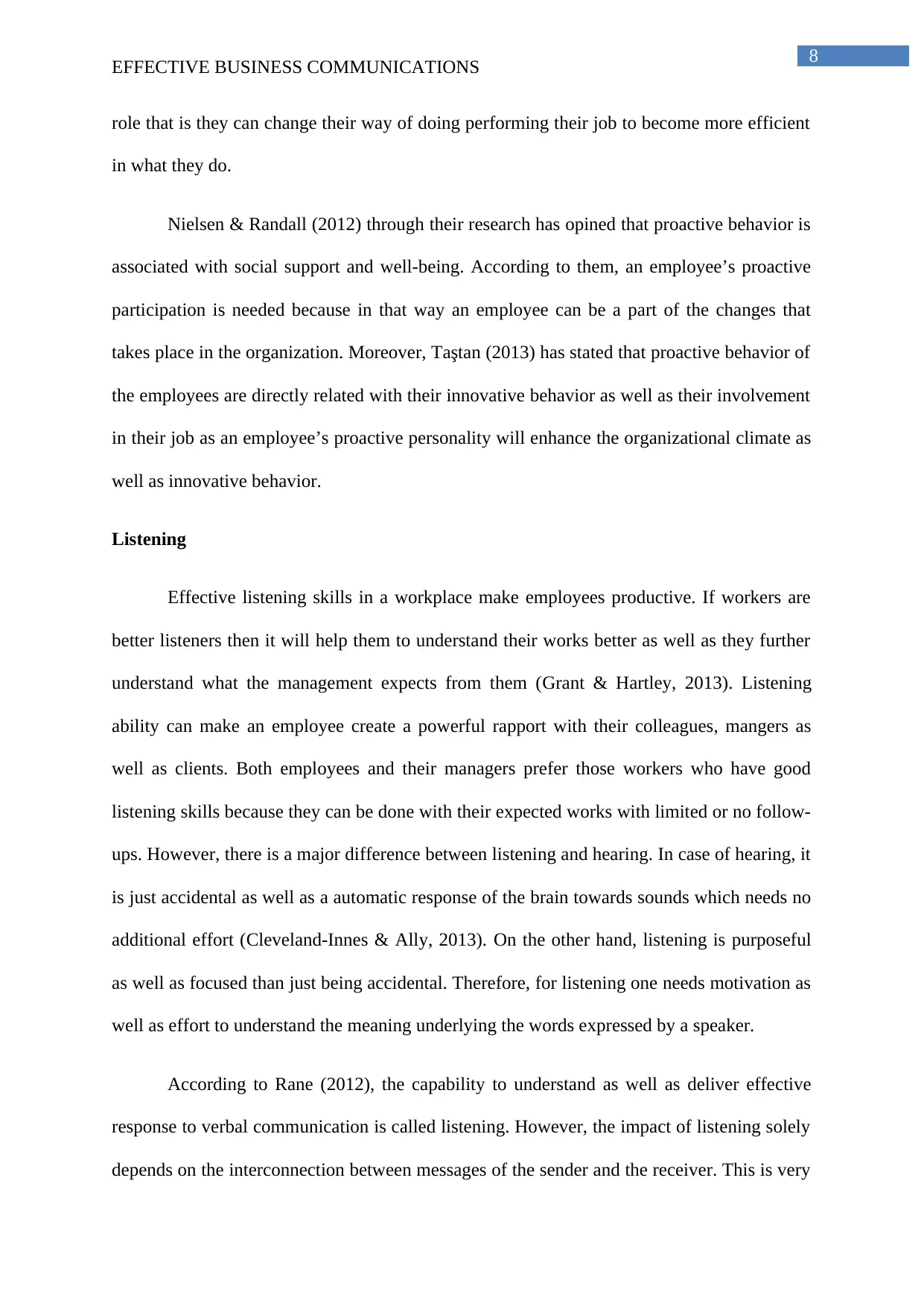
8
EFFECTIVE BUSINESS COMMUNICATIONS
role that is they can change their way of doing performing their job to become more efficient
in what they do.
Nielsen & Randall (2012) through their research has opined that proactive behavior is
associated with social support and well-being. According to them, an employee’s proactive
participation is needed because in that way an employee can be a part of the changes that
takes place in the organization. Moreover, Taştan (2013) has stated that proactive behavior of
the employees are directly related with their innovative behavior as well as their involvement
in their job as an employee’s proactive personality will enhance the organizational climate as
well as innovative behavior.
Listening
Effective listening skills in a workplace make employees productive. If workers are
better listeners then it will help them to understand their works better as well as they further
understand what the management expects from them (Grant & Hartley, 2013). Listening
ability can make an employee create a powerful rapport with their colleagues, mangers as
well as clients. Both employees and their managers prefer those workers who have good
listening skills because they can be done with their expected works with limited or no follow-
ups. However, there is a major difference between listening and hearing. In case of hearing, it
is just accidental as well as a automatic response of the brain towards sounds which needs no
additional effort (Cleveland-Innes & Ally, 2013). On the other hand, listening is purposeful
as well as focused than just being accidental. Therefore, for listening one needs motivation as
well as effort to understand the meaning underlying the words expressed by a speaker.
According to Rane (2012), the capability to understand as well as deliver effective
response to verbal communication is called listening. However, the impact of listening solely
depends on the interconnection between messages of the sender and the receiver. This is very
EFFECTIVE BUSINESS COMMUNICATIONS
role that is they can change their way of doing performing their job to become more efficient
in what they do.
Nielsen & Randall (2012) through their research has opined that proactive behavior is
associated with social support and well-being. According to them, an employee’s proactive
participation is needed because in that way an employee can be a part of the changes that
takes place in the organization. Moreover, Taştan (2013) has stated that proactive behavior of
the employees are directly related with their innovative behavior as well as their involvement
in their job as an employee’s proactive personality will enhance the organizational climate as
well as innovative behavior.
Listening
Effective listening skills in a workplace make employees productive. If workers are
better listeners then it will help them to understand their works better as well as they further
understand what the management expects from them (Grant & Hartley, 2013). Listening
ability can make an employee create a powerful rapport with their colleagues, mangers as
well as clients. Both employees and their managers prefer those workers who have good
listening skills because they can be done with their expected works with limited or no follow-
ups. However, there is a major difference between listening and hearing. In case of hearing, it
is just accidental as well as a automatic response of the brain towards sounds which needs no
additional effort (Cleveland-Innes & Ally, 2013). On the other hand, listening is purposeful
as well as focused than just being accidental. Therefore, for listening one needs motivation as
well as effort to understand the meaning underlying the words expressed by a speaker.
According to Rane (2012), the capability to understand as well as deliver effective
response to verbal communication is called listening. However, the impact of listening solely
depends on the interconnection between messages of the sender and the receiver. This is very
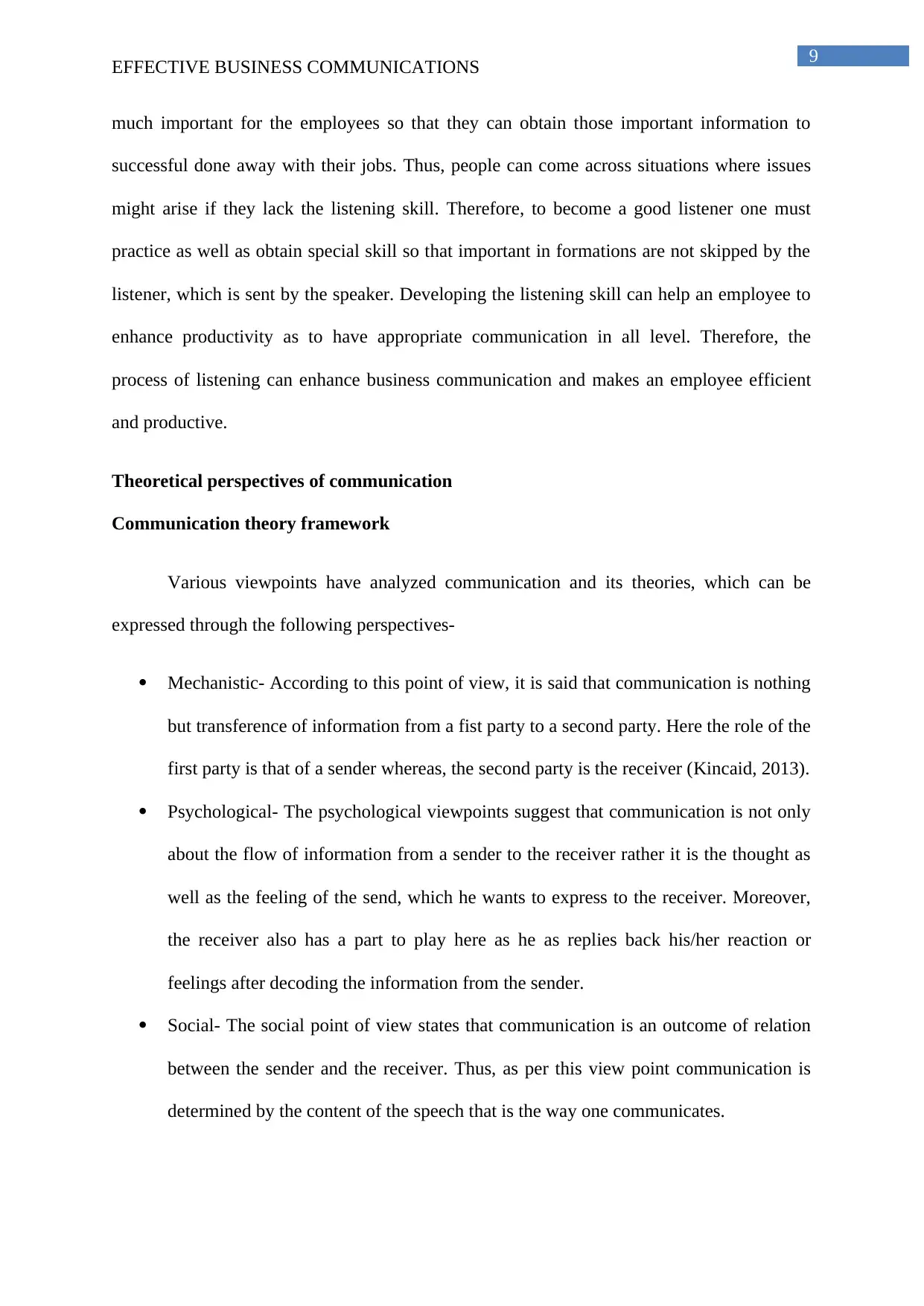
9
EFFECTIVE BUSINESS COMMUNICATIONS
much important for the employees so that they can obtain those important information to
successful done away with their jobs. Thus, people can come across situations where issues
might arise if they lack the listening skill. Therefore, to become a good listener one must
practice as well as obtain special skill so that important in formations are not skipped by the
listener, which is sent by the speaker. Developing the listening skill can help an employee to
enhance productivity as to have appropriate communication in all level. Therefore, the
process of listening can enhance business communication and makes an employee efficient
and productive.
Theoretical perspectives of communication
Communication theory framework
Various viewpoints have analyzed communication and its theories, which can be
expressed through the following perspectives-
Mechanistic- According to this point of view, it is said that communication is nothing
but transference of information from a fist party to a second party. Here the role of the
first party is that of a sender whereas, the second party is the receiver (Kincaid, 2013).
Psychological- The psychological viewpoints suggest that communication is not only
about the flow of information from a sender to the receiver rather it is the thought as
well as the feeling of the send, which he wants to express to the receiver. Moreover,
the receiver also has a part to play here as he as replies back his/her reaction or
feelings after decoding the information from the sender.
Social- The social point of view states that communication is an outcome of relation
between the sender and the receiver. Thus, as per this view point communication is
determined by the content of the speech that is the way one communicates.
EFFECTIVE BUSINESS COMMUNICATIONS
much important for the employees so that they can obtain those important information to
successful done away with their jobs. Thus, people can come across situations where issues
might arise if they lack the listening skill. Therefore, to become a good listener one must
practice as well as obtain special skill so that important in formations are not skipped by the
listener, which is sent by the speaker. Developing the listening skill can help an employee to
enhance productivity as to have appropriate communication in all level. Therefore, the
process of listening can enhance business communication and makes an employee efficient
and productive.
Theoretical perspectives of communication
Communication theory framework
Various viewpoints have analyzed communication and its theories, which can be
expressed through the following perspectives-
Mechanistic- According to this point of view, it is said that communication is nothing
but transference of information from a fist party to a second party. Here the role of the
first party is that of a sender whereas, the second party is the receiver (Kincaid, 2013).
Psychological- The psychological viewpoints suggest that communication is not only
about the flow of information from a sender to the receiver rather it is the thought as
well as the feeling of the send, which he wants to express to the receiver. Moreover,
the receiver also has a part to play here as he as replies back his/her reaction or
feelings after decoding the information from the sender.
Social- The social point of view states that communication is an outcome of relation
between the sender and the receiver. Thus, as per this view point communication is
determined by the content of the speech that is the way one communicates.
Secure Best Marks with AI Grader
Need help grading? Try our AI Grader for instant feedback on your assignments.
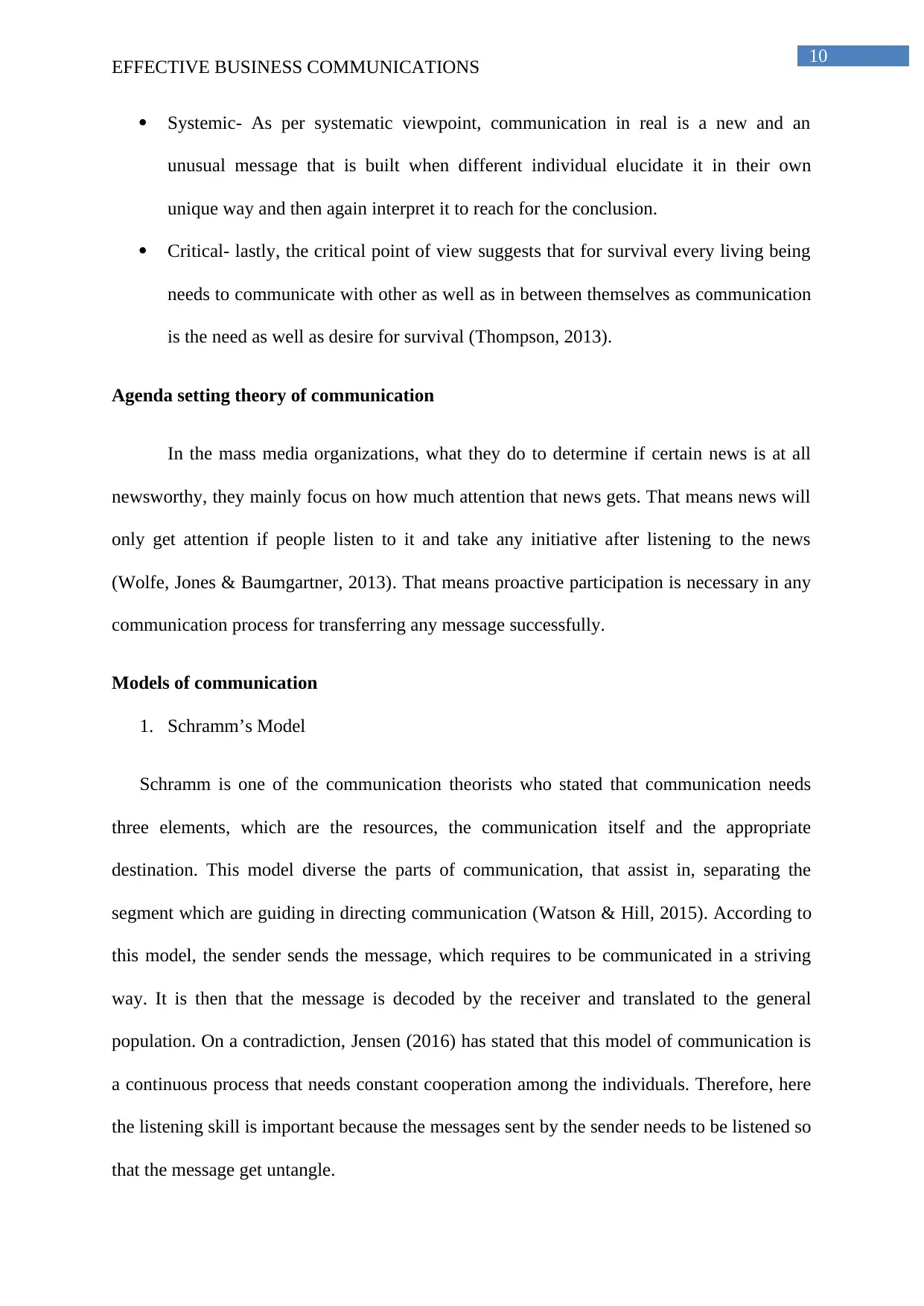
10
EFFECTIVE BUSINESS COMMUNICATIONS
Systemic- As per systematic viewpoint, communication in real is a new and an
unusual message that is built when different individual elucidate it in their own
unique way and then again interpret it to reach for the conclusion.
Critical- lastly, the critical point of view suggests that for survival every living being
needs to communicate with other as well as in between themselves as communication
is the need as well as desire for survival (Thompson, 2013).
Agenda setting theory of communication
In the mass media organizations, what they do to determine if certain news is at all
newsworthy, they mainly focus on how much attention that news gets. That means news will
only get attention if people listen to it and take any initiative after listening to the news
(Wolfe, Jones & Baumgartner, 2013). That means proactive participation is necessary in any
communication process for transferring any message successfully.
Models of communication
1. Schramm’s Model
Schramm is one of the communication theorists who stated that communication needs
three elements, which are the resources, the communication itself and the appropriate
destination. This model diverse the parts of communication, that assist in, separating the
segment which are guiding in directing communication (Watson & Hill, 2015). According to
this model, the sender sends the message, which requires to be communicated in a striving
way. It is then that the message is decoded by the receiver and translated to the general
population. On a contradiction, Jensen (2016) has stated that this model of communication is
a continuous process that needs constant cooperation among the individuals. Therefore, here
the listening skill is important because the messages sent by the sender needs to be listened so
that the message get untangle.
EFFECTIVE BUSINESS COMMUNICATIONS
Systemic- As per systematic viewpoint, communication in real is a new and an
unusual message that is built when different individual elucidate it in their own
unique way and then again interpret it to reach for the conclusion.
Critical- lastly, the critical point of view suggests that for survival every living being
needs to communicate with other as well as in between themselves as communication
is the need as well as desire for survival (Thompson, 2013).
Agenda setting theory of communication
In the mass media organizations, what they do to determine if certain news is at all
newsworthy, they mainly focus on how much attention that news gets. That means news will
only get attention if people listen to it and take any initiative after listening to the news
(Wolfe, Jones & Baumgartner, 2013). That means proactive participation is necessary in any
communication process for transferring any message successfully.
Models of communication
1. Schramm’s Model
Schramm is one of the communication theorists who stated that communication needs
three elements, which are the resources, the communication itself and the appropriate
destination. This model diverse the parts of communication, that assist in, separating the
segment which are guiding in directing communication (Watson & Hill, 2015). According to
this model, the sender sends the message, which requires to be communicated in a striving
way. It is then that the message is decoded by the receiver and translated to the general
population. On a contradiction, Jensen (2016) has stated that this model of communication is
a continuous process that needs constant cooperation among the individuals. Therefore, here
the listening skill is important because the messages sent by the sender needs to be listened so
that the message get untangle.
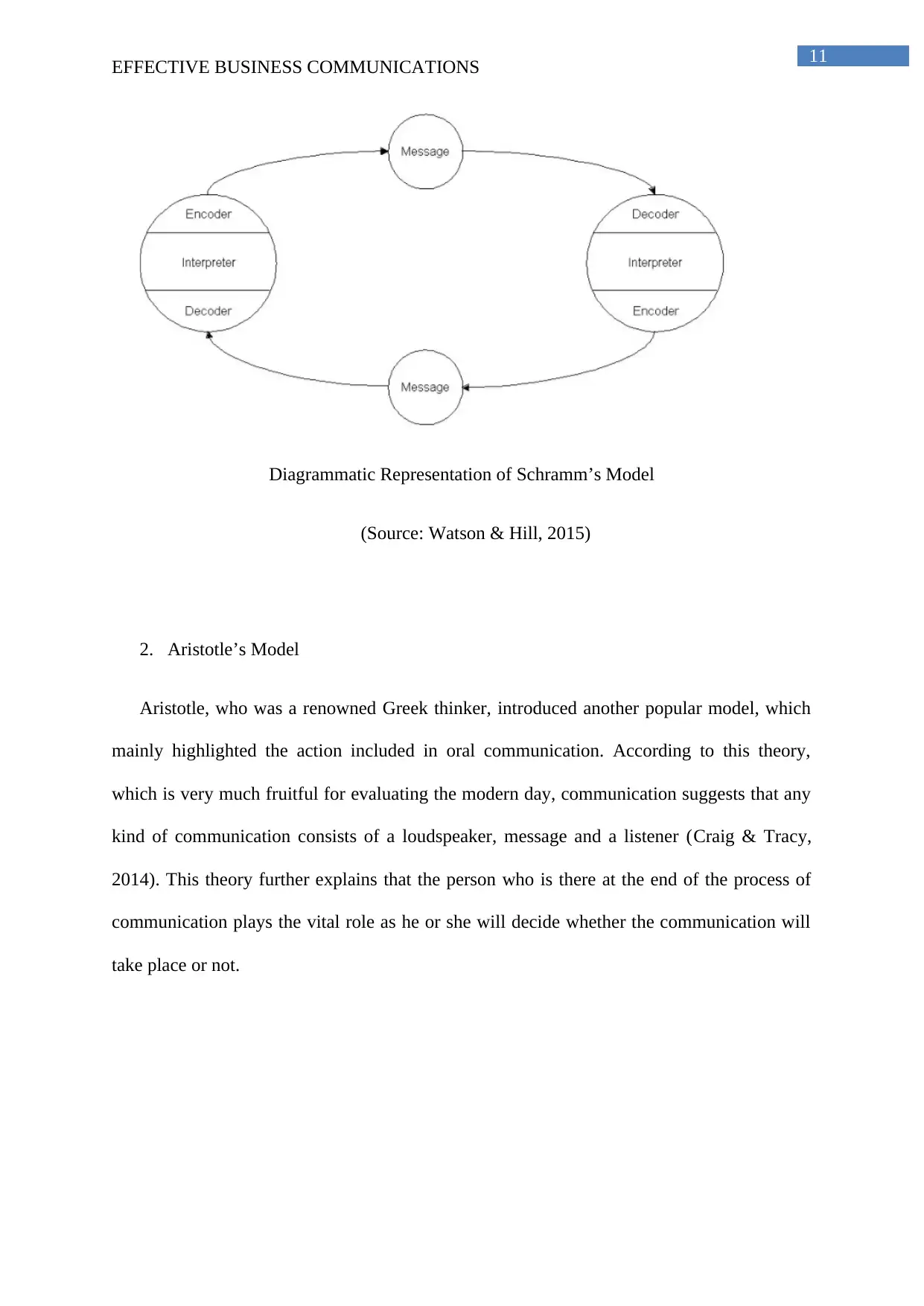
11
EFFECTIVE BUSINESS COMMUNICATIONS
Diagrammatic Representation of Schramm’s Model
(Source: Watson & Hill, 2015)
2. Aristotle’s Model
Aristotle, who was a renowned Greek thinker, introduced another popular model, which
mainly highlighted the action included in oral communication. According to this theory,
which is very much fruitful for evaluating the modern day, communication suggests that any
kind of communication consists of a loudspeaker, message and a listener (Craig & Tracy,
2014). This theory further explains that the person who is there at the end of the process of
communication plays the vital role as he or she will decide whether the communication will
take place or not.
EFFECTIVE BUSINESS COMMUNICATIONS
Diagrammatic Representation of Schramm’s Model
(Source: Watson & Hill, 2015)
2. Aristotle’s Model
Aristotle, who was a renowned Greek thinker, introduced another popular model, which
mainly highlighted the action included in oral communication. According to this theory,
which is very much fruitful for evaluating the modern day, communication suggests that any
kind of communication consists of a loudspeaker, message and a listener (Craig & Tracy,
2014). This theory further explains that the person who is there at the end of the process of
communication plays the vital role as he or she will decide whether the communication will
take place or not.
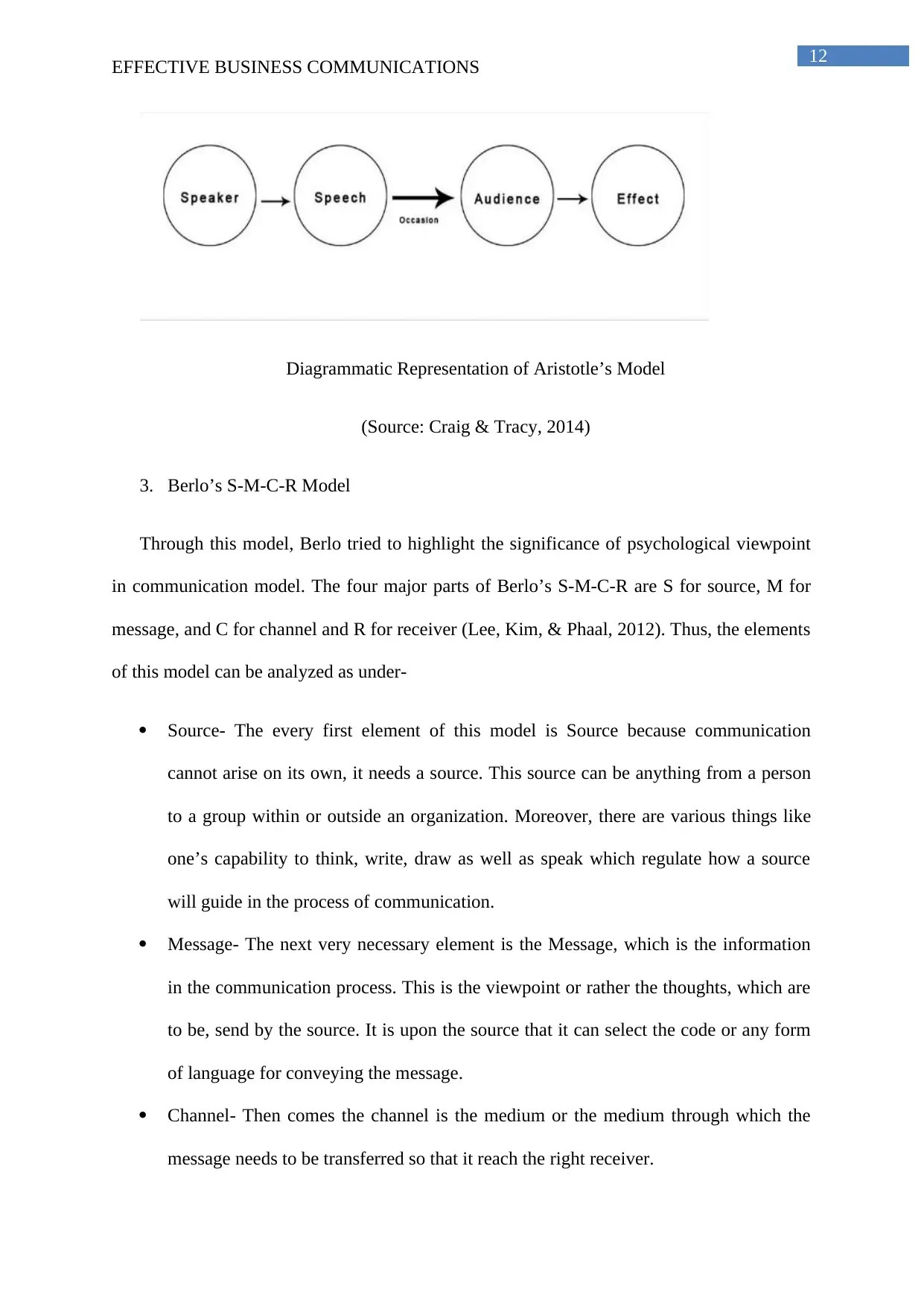
12
EFFECTIVE BUSINESS COMMUNICATIONS
Diagrammatic Representation of Aristotle’s Model
(Source: Craig & Tracy, 2014)
3. Berlo’s S-M-C-R Model
Through this model, Berlo tried to highlight the significance of psychological viewpoint
in communication model. The four major parts of Berlo’s S-M-C-R are S for source, M for
message, and C for channel and R for receiver (Lee, Kim, & Phaal, 2012). Thus, the elements
of this model can be analyzed as under-
Source- The every first element of this model is Source because communication
cannot arise on its own, it needs a source. This source can be anything from a person
to a group within or outside an organization. Moreover, there are various things like
one’s capability to think, write, draw as well as speak which regulate how a source
will guide in the process of communication.
Message- The next very necessary element is the Message, which is the information
in the communication process. This is the viewpoint or rather the thoughts, which are
to be, send by the source. It is upon the source that it can select the code or any form
of language for conveying the message.
Channel- Then comes the channel is the medium or the medium through which the
message needs to be transferred so that it reach the right receiver.
EFFECTIVE BUSINESS COMMUNICATIONS
Diagrammatic Representation of Aristotle’s Model
(Source: Craig & Tracy, 2014)
3. Berlo’s S-M-C-R Model
Through this model, Berlo tried to highlight the significance of psychological viewpoint
in communication model. The four major parts of Berlo’s S-M-C-R are S for source, M for
message, and C for channel and R for receiver (Lee, Kim, & Phaal, 2012). Thus, the elements
of this model can be analyzed as under-
Source- The every first element of this model is Source because communication
cannot arise on its own, it needs a source. This source can be anything from a person
to a group within or outside an organization. Moreover, there are various things like
one’s capability to think, write, draw as well as speak which regulate how a source
will guide in the process of communication.
Message- The next very necessary element is the Message, which is the information
in the communication process. This is the viewpoint or rather the thoughts, which are
to be, send by the source. It is upon the source that it can select the code or any form
of language for conveying the message.
Channel- Then comes the channel is the medium or the medium through which the
message needs to be transferred so that it reach the right receiver.
Paraphrase This Document
Need a fresh take? Get an instant paraphrase of this document with our AI Paraphraser
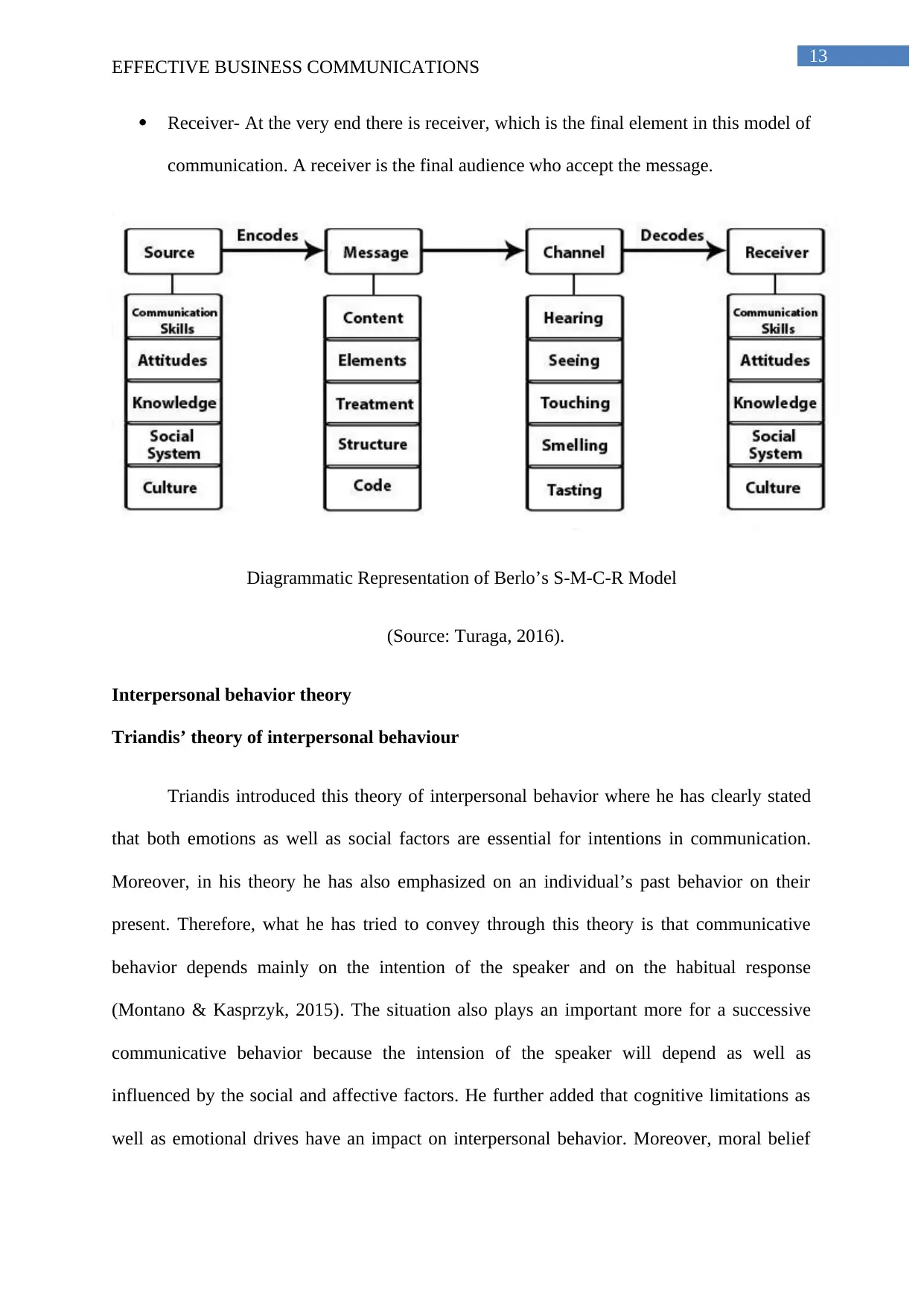
13
EFFECTIVE BUSINESS COMMUNICATIONS
Receiver- At the very end there is receiver, which is the final element in this model of
communication. A receiver is the final audience who accept the message.
Diagrammatic Representation of Berlo’s S-M-C-R Model
(Source: Turaga, 2016).
Interpersonal behavior theory
Triandis’ theory of interpersonal behaviour
Triandis introduced this theory of interpersonal behavior where he has clearly stated
that both emotions as well as social factors are essential for intentions in communication.
Moreover, in his theory he has also emphasized on an individual’s past behavior on their
present. Therefore, what he has tried to convey through this theory is that communicative
behavior depends mainly on the intention of the speaker and on the habitual response
(Montano & Kasprzyk, 2015). The situation also plays an important more for a successive
communicative behavior because the intension of the speaker will depend as well as
influenced by the social and affective factors. He further added that cognitive limitations as
well as emotional drives have an impact on interpersonal behavior. Moreover, moral belief
EFFECTIVE BUSINESS COMMUNICATIONS
Receiver- At the very end there is receiver, which is the final element in this model of
communication. A receiver is the final audience who accept the message.
Diagrammatic Representation of Berlo’s S-M-C-R Model
(Source: Turaga, 2016).
Interpersonal behavior theory
Triandis’ theory of interpersonal behaviour
Triandis introduced this theory of interpersonal behavior where he has clearly stated
that both emotions as well as social factors are essential for intentions in communication.
Moreover, in his theory he has also emphasized on an individual’s past behavior on their
present. Therefore, what he has tried to convey through this theory is that communicative
behavior depends mainly on the intention of the speaker and on the habitual response
(Montano & Kasprzyk, 2015). The situation also plays an important more for a successive
communicative behavior because the intension of the speaker will depend as well as
influenced by the social and affective factors. He further added that cognitive limitations as
well as emotional drives have an impact on interpersonal behavior. Moreover, moral belief
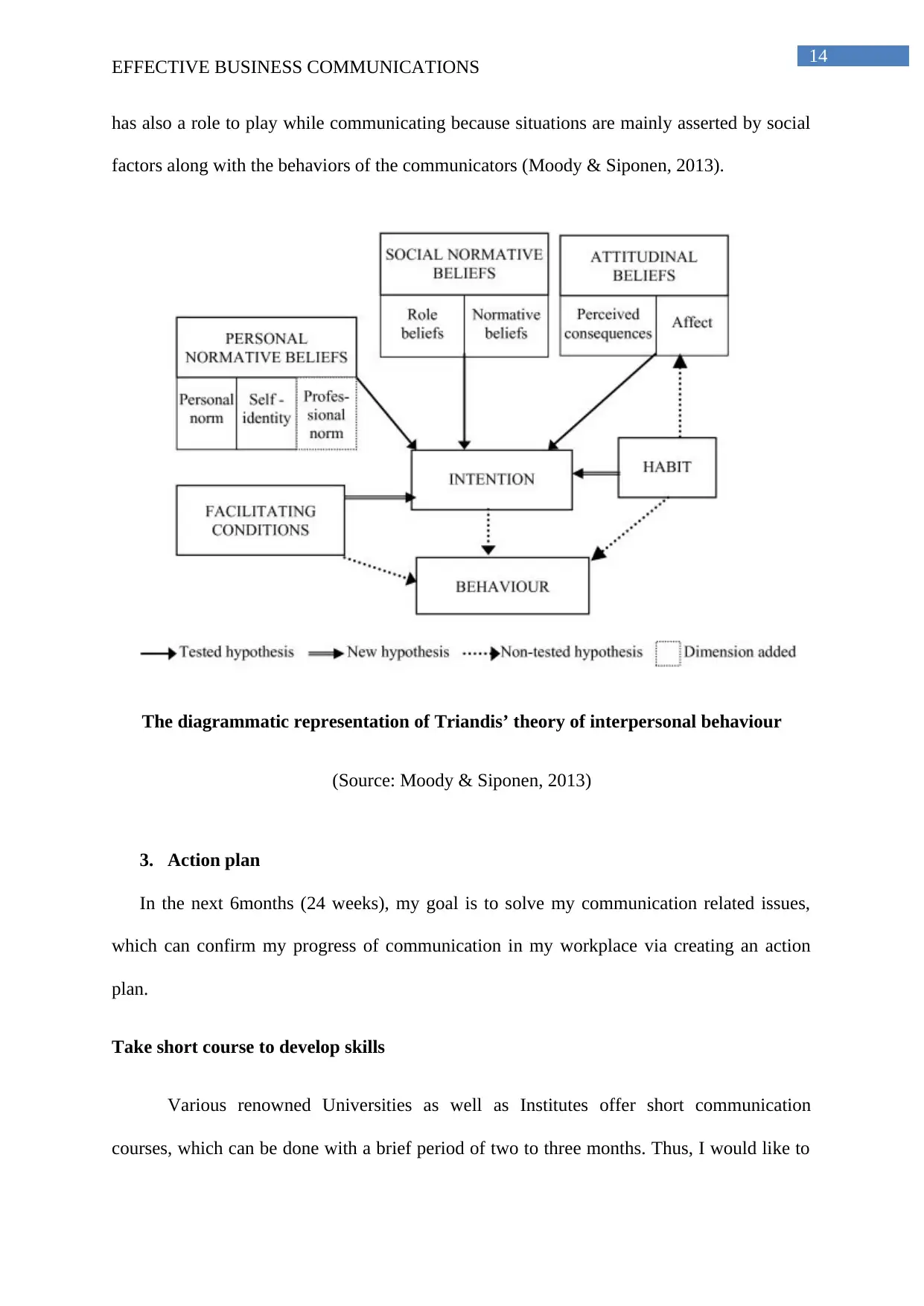
14
EFFECTIVE BUSINESS COMMUNICATIONS
has also a role to play while communicating because situations are mainly asserted by social
factors along with the behaviors of the communicators (Moody & Siponen, 2013).
The diagrammatic representation of Triandis’ theory of interpersonal behaviour
(Source: Moody & Siponen, 2013)
3. Action plan
In the next 6months (24 weeks), my goal is to solve my communication related issues,
which can confirm my progress of communication in my workplace via creating an action
plan.
Take short course to develop skills
Various renowned Universities as well as Institutes offer short communication
courses, which can be done with a brief period of two to three months. Thus, I would like to
EFFECTIVE BUSINESS COMMUNICATIONS
has also a role to play while communicating because situations are mainly asserted by social
factors along with the behaviors of the communicators (Moody & Siponen, 2013).
The diagrammatic representation of Triandis’ theory of interpersonal behaviour
(Source: Moody & Siponen, 2013)
3. Action plan
In the next 6months (24 weeks), my goal is to solve my communication related issues,
which can confirm my progress of communication in my workplace via creating an action
plan.
Take short course to develop skills
Various renowned Universities as well as Institutes offer short communication
courses, which can be done with a brief period of two to three months. Thus, I would like to
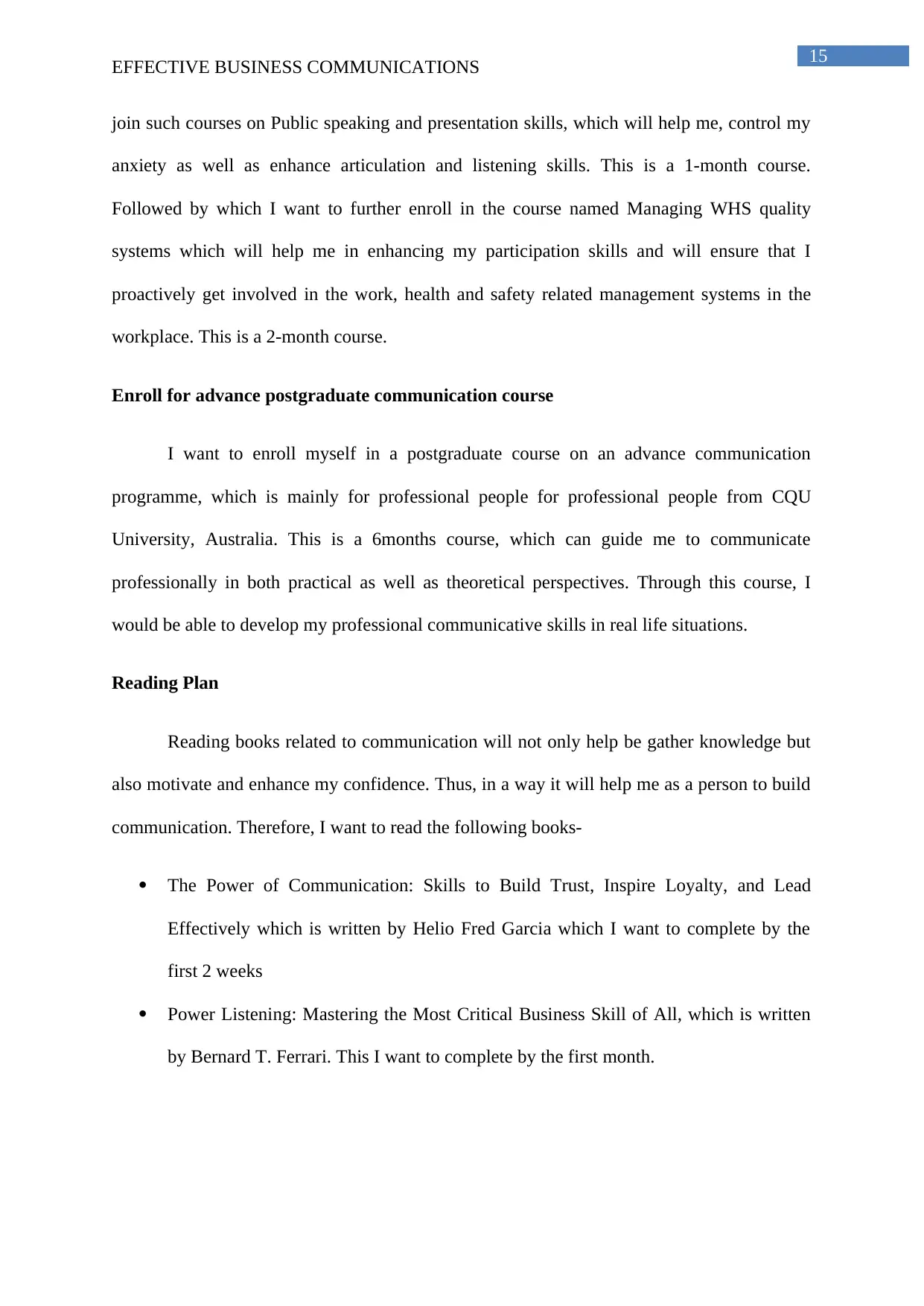
15
EFFECTIVE BUSINESS COMMUNICATIONS
join such courses on Public speaking and presentation skills, which will help me, control my
anxiety as well as enhance articulation and listening skills. This is a 1-month course.
Followed by which I want to further enroll in the course named Managing WHS quality
systems which will help me in enhancing my participation skills and will ensure that I
proactively get involved in the work, health and safety related management systems in the
workplace. This is a 2-month course.
Enroll for advance postgraduate communication course
I want to enroll myself in a postgraduate course on an advance communication
programme, which is mainly for professional people for professional people from CQU
University, Australia. This is a 6months course, which can guide me to communicate
professionally in both practical as well as theoretical perspectives. Through this course, I
would be able to develop my professional communicative skills in real life situations.
Reading Plan
Reading books related to communication will not only help be gather knowledge but
also motivate and enhance my confidence. Thus, in a way it will help me as a person to build
communication. Therefore, I want to read the following books-
The Power of Communication: Skills to Build Trust, Inspire Loyalty, and Lead
Effectively which is written by Helio Fred Garcia which I want to complete by the
first 2 weeks
Power Listening: Mastering the Most Critical Business Skill of All, which is written
by Bernard T. Ferrari. This I want to complete by the first month.
EFFECTIVE BUSINESS COMMUNICATIONS
join such courses on Public speaking and presentation skills, which will help me, control my
anxiety as well as enhance articulation and listening skills. This is a 1-month course.
Followed by which I want to further enroll in the course named Managing WHS quality
systems which will help me in enhancing my participation skills and will ensure that I
proactively get involved in the work, health and safety related management systems in the
workplace. This is a 2-month course.
Enroll for advance postgraduate communication course
I want to enroll myself in a postgraduate course on an advance communication
programme, which is mainly for professional people for professional people from CQU
University, Australia. This is a 6months course, which can guide me to communicate
professionally in both practical as well as theoretical perspectives. Through this course, I
would be able to develop my professional communicative skills in real life situations.
Reading Plan
Reading books related to communication will not only help be gather knowledge but
also motivate and enhance my confidence. Thus, in a way it will help me as a person to build
communication. Therefore, I want to read the following books-
The Power of Communication: Skills to Build Trust, Inspire Loyalty, and Lead
Effectively which is written by Helio Fred Garcia which I want to complete by the
first 2 weeks
Power Listening: Mastering the Most Critical Business Skill of All, which is written
by Bernard T. Ferrari. This I want to complete by the first month.
Secure Best Marks with AI Grader
Need help grading? Try our AI Grader for instant feedback on your assignments.
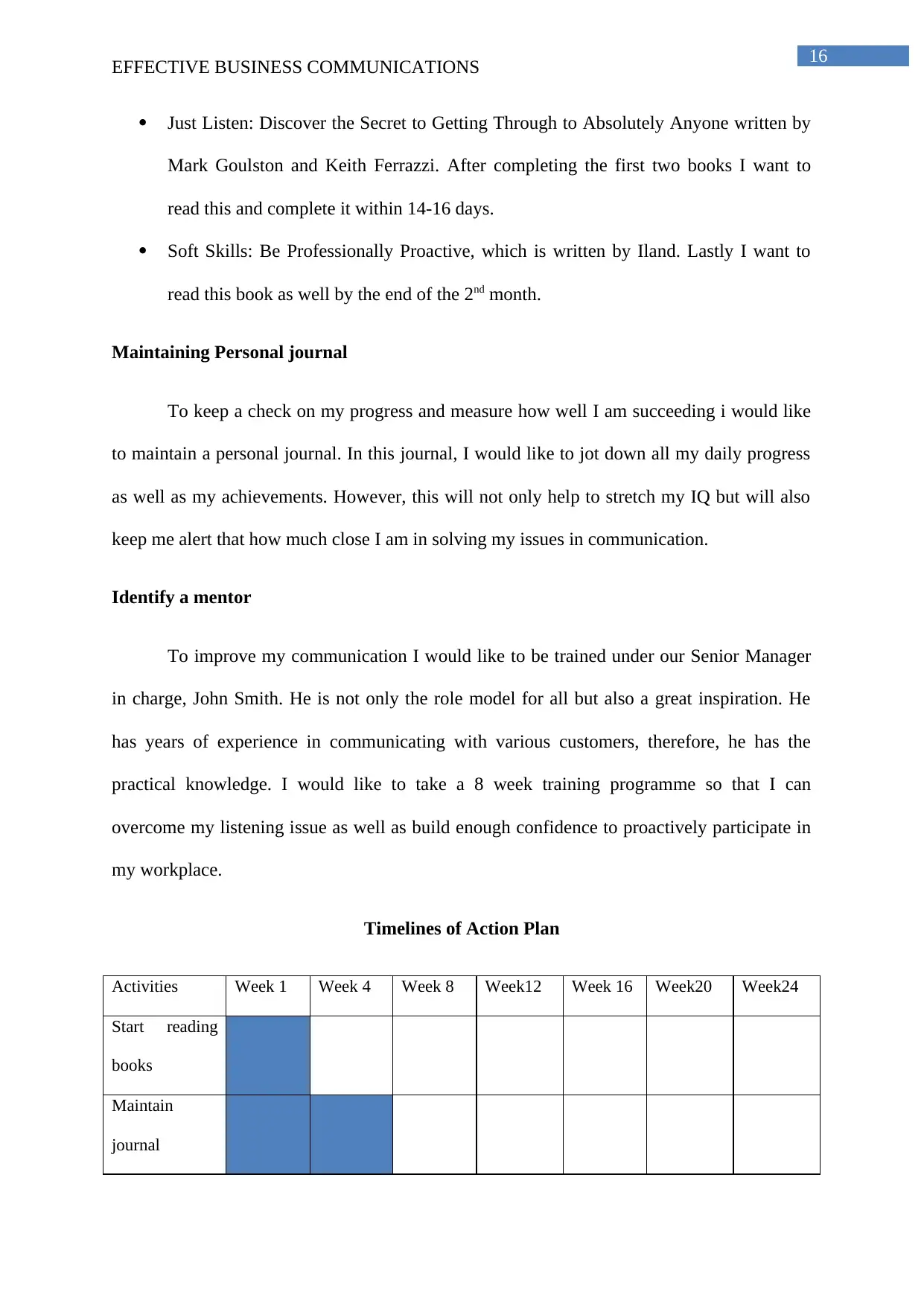
16
EFFECTIVE BUSINESS COMMUNICATIONS
Just Listen: Discover the Secret to Getting Through to Absolutely Anyone written by
Mark Goulston and Keith Ferrazzi. After completing the first two books I want to
read this and complete it within 14-16 days.
Soft Skills: Be Professionally Proactive, which is written by Iland. Lastly I want to
read this book as well by the end of the 2nd month.
Maintaining Personal journal
To keep a check on my progress and measure how well I am succeeding i would like
to maintain a personal journal. In this journal, I would like to jot down all my daily progress
as well as my achievements. However, this will not only help to stretch my IQ but will also
keep me alert that how much close I am in solving my issues in communication.
Identify a mentor
To improve my communication I would like to be trained under our Senior Manager
in charge, John Smith. He is not only the role model for all but also a great inspiration. He
has years of experience in communicating with various customers, therefore, he has the
practical knowledge. I would like to take a 8 week training programme so that I can
overcome my listening issue as well as build enough confidence to proactively participate in
my workplace.
Timelines of Action Plan
Activities Week 1 Week 4 Week 8 Week12 Week 16 Week20 Week24
Start reading
books
Maintain
journal
EFFECTIVE BUSINESS COMMUNICATIONS
Just Listen: Discover the Secret to Getting Through to Absolutely Anyone written by
Mark Goulston and Keith Ferrazzi. After completing the first two books I want to
read this and complete it within 14-16 days.
Soft Skills: Be Professionally Proactive, which is written by Iland. Lastly I want to
read this book as well by the end of the 2nd month.
Maintaining Personal journal
To keep a check on my progress and measure how well I am succeeding i would like
to maintain a personal journal. In this journal, I would like to jot down all my daily progress
as well as my achievements. However, this will not only help to stretch my IQ but will also
keep me alert that how much close I am in solving my issues in communication.
Identify a mentor
To improve my communication I would like to be trained under our Senior Manager
in charge, John Smith. He is not only the role model for all but also a great inspiration. He
has years of experience in communicating with various customers, therefore, he has the
practical knowledge. I would like to take a 8 week training programme so that I can
overcome my listening issue as well as build enough confidence to proactively participate in
my workplace.
Timelines of Action Plan
Activities Week 1 Week 4 Week 8 Week12 Week 16 Week20 Week24
Start reading
books
Maintain
journal
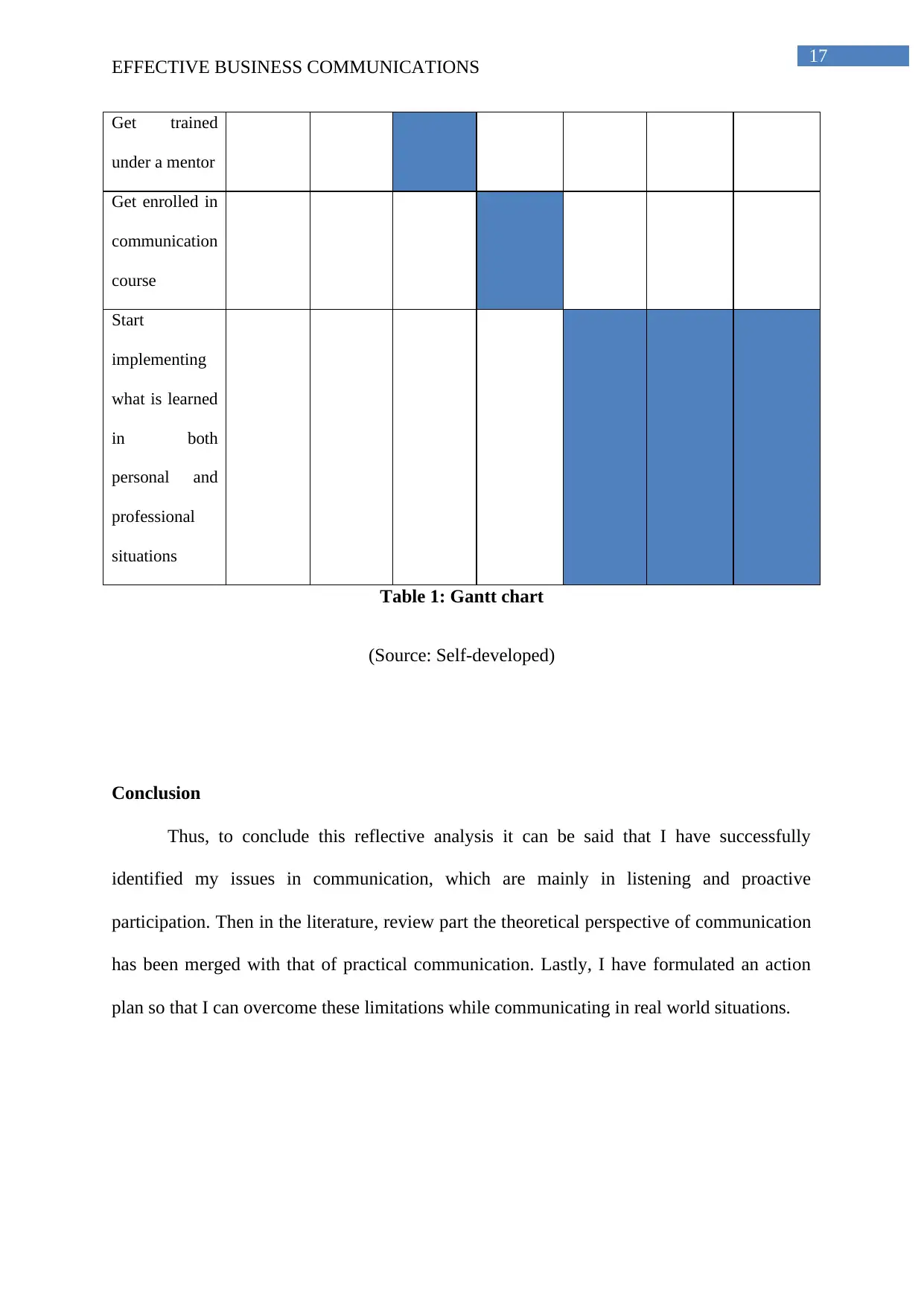
17
EFFECTIVE BUSINESS COMMUNICATIONS
Get trained
under a mentor
Get enrolled in
communication
course
Start
implementing
what is learned
in both
personal and
professional
situations
Table 1: Gantt chart
(Source: Self-developed)
Conclusion
Thus, to conclude this reflective analysis it can be said that I have successfully
identified my issues in communication, which are mainly in listening and proactive
participation. Then in the literature, review part the theoretical perspective of communication
has been merged with that of practical communication. Lastly, I have formulated an action
plan so that I can overcome these limitations while communicating in real world situations.
EFFECTIVE BUSINESS COMMUNICATIONS
Get trained
under a mentor
Get enrolled in
communication
course
Start
implementing
what is learned
in both
personal and
professional
situations
Table 1: Gantt chart
(Source: Self-developed)
Conclusion
Thus, to conclude this reflective analysis it can be said that I have successfully
identified my issues in communication, which are mainly in listening and proactive
participation. Then in the literature, review part the theoretical perspective of communication
has been merged with that of practical communication. Lastly, I have formulated an action
plan so that I can overcome these limitations while communicating in real world situations.
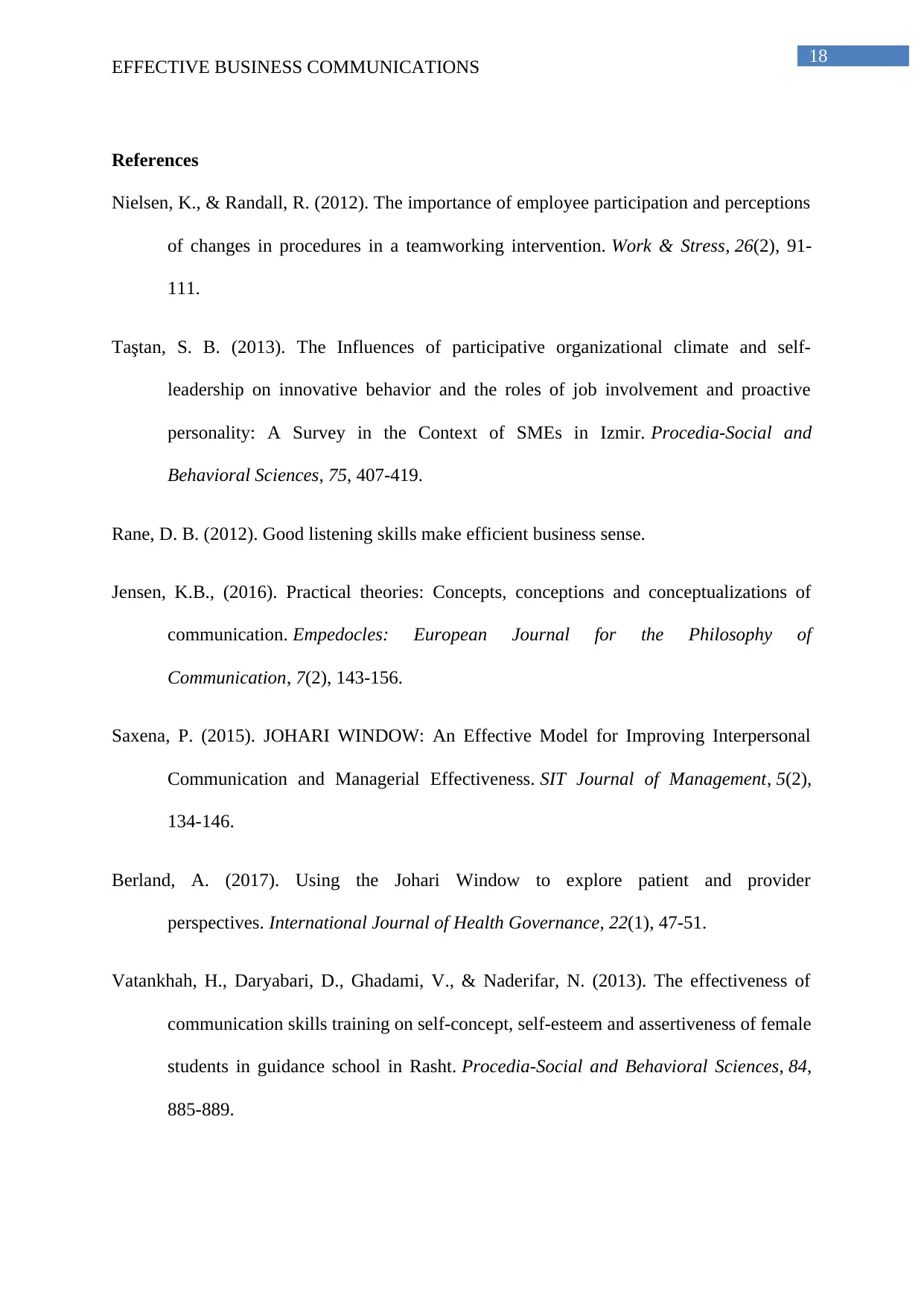
18
EFFECTIVE BUSINESS COMMUNICATIONS
References
Nielsen, K., & Randall, R. (2012). The importance of employee participation and perceptions
of changes in procedures in a teamworking intervention. Work & Stress, 26(2), 91-
111.
Taştan, S. B. (2013). The Influences of participative organizational climate and self-
leadership on innovative behavior and the roles of job involvement and proactive
personality: A Survey in the Context of SMEs in Izmir. Procedia-Social and
Behavioral Sciences, 75, 407-419.
Rane, D. B. (2012). Good listening skills make efficient business sense.
Jensen, K.B., (2016). Practical theories: Concepts, conceptions and conceptualizations of
communication. Empedocles: European Journal for the Philosophy of
Communication, 7(2), 143-156.
Saxena, P. (2015). JOHARI WINDOW: An Effective Model for Improving Interpersonal
Communication and Managerial Effectiveness. SIT Journal of Management, 5(2),
134-146.
Berland, A. (2017). Using the Johari Window to explore patient and provider
perspectives. International Journal of Health Governance, 22(1), 47-51.
Vatankhah, H., Daryabari, D., Ghadami, V., & Naderifar, N. (2013). The effectiveness of
communication skills training on self-concept, self-esteem and assertiveness of female
students in guidance school in Rasht. Procedia-Social and Behavioral Sciences, 84,
885-889.
EFFECTIVE BUSINESS COMMUNICATIONS
References
Nielsen, K., & Randall, R. (2012). The importance of employee participation and perceptions
of changes in procedures in a teamworking intervention. Work & Stress, 26(2), 91-
111.
Taştan, S. B. (2013). The Influences of participative organizational climate and self-
leadership on innovative behavior and the roles of job involvement and proactive
personality: A Survey in the Context of SMEs in Izmir. Procedia-Social and
Behavioral Sciences, 75, 407-419.
Rane, D. B. (2012). Good listening skills make efficient business sense.
Jensen, K.B., (2016). Practical theories: Concepts, conceptions and conceptualizations of
communication. Empedocles: European Journal for the Philosophy of
Communication, 7(2), 143-156.
Saxena, P. (2015). JOHARI WINDOW: An Effective Model for Improving Interpersonal
Communication and Managerial Effectiveness. SIT Journal of Management, 5(2),
134-146.
Berland, A. (2017). Using the Johari Window to explore patient and provider
perspectives. International Journal of Health Governance, 22(1), 47-51.
Vatankhah, H., Daryabari, D., Ghadami, V., & Naderifar, N. (2013). The effectiveness of
communication skills training on self-concept, self-esteem and assertiveness of female
students in guidance school in Rasht. Procedia-Social and Behavioral Sciences, 84,
885-889.
Paraphrase This Document
Need a fresh take? Get an instant paraphrase of this document with our AI Paraphraser
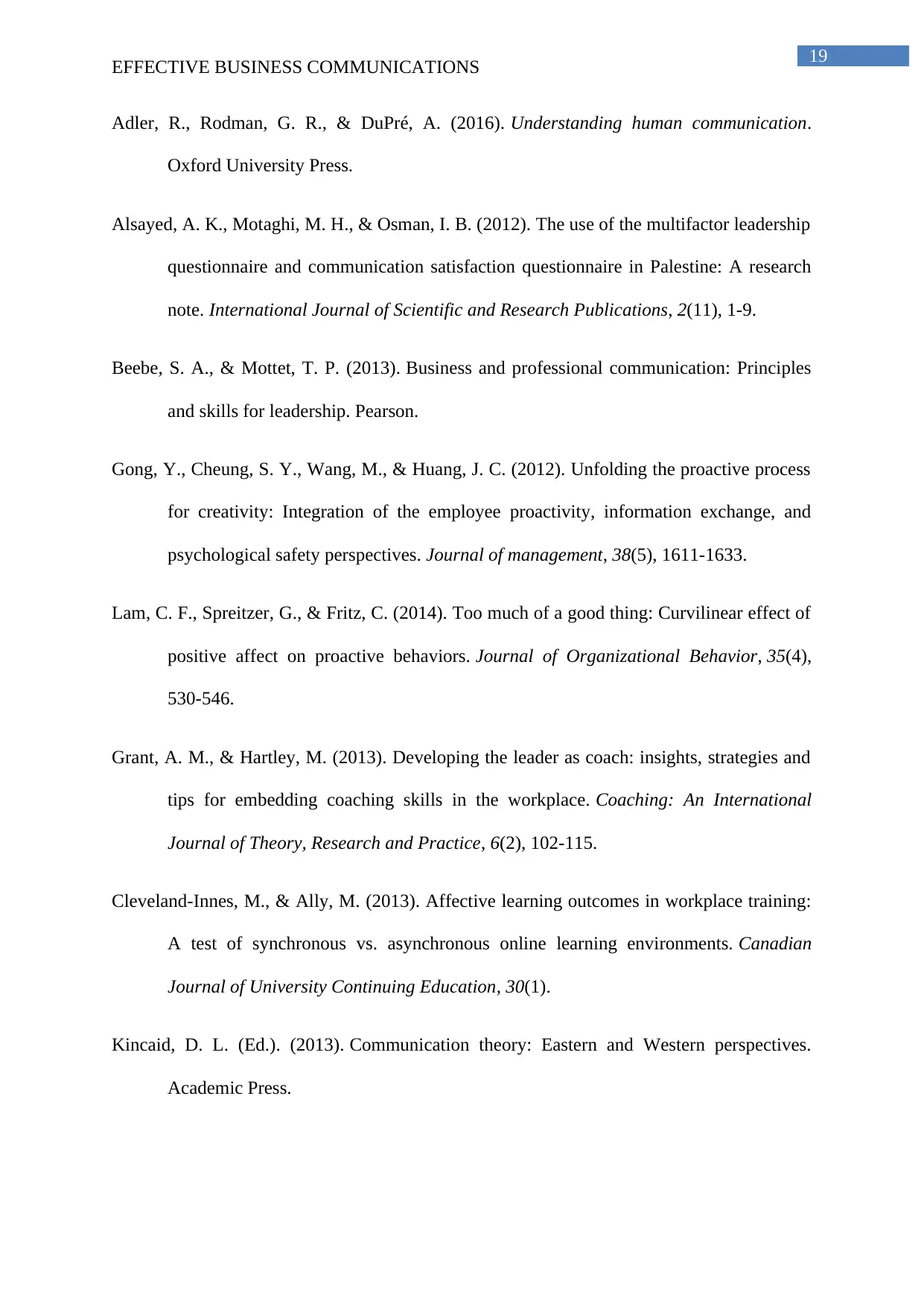
19
EFFECTIVE BUSINESS COMMUNICATIONS
Adler, R., Rodman, G. R., & DuPré, A. (2016). Understanding human communication.
Oxford University Press.
Alsayed, A. K., Motaghi, M. H., & Osman, I. B. (2012). The use of the multifactor leadership
questionnaire and communication satisfaction questionnaire in Palestine: A research
note. International Journal of Scientific and Research Publications, 2(11), 1-9.
Beebe, S. A., & Mottet, T. P. (2013). Business and professional communication: Principles
and skills for leadership. Pearson.
Gong, Y., Cheung, S. Y., Wang, M., & Huang, J. C. (2012). Unfolding the proactive process
for creativity: Integration of the employee proactivity, information exchange, and
psychological safety perspectives. Journal of management, 38(5), 1611-1633.
Lam, C. F., Spreitzer, G., & Fritz, C. (2014). Too much of a good thing: Curvilinear effect of
positive affect on proactive behaviors. Journal of Organizational Behavior, 35(4),
530-546.
Grant, A. M., & Hartley, M. (2013). Developing the leader as coach: insights, strategies and
tips for embedding coaching skills in the workplace. Coaching: An International
Journal of Theory, Research and Practice, 6(2), 102-115.
Cleveland-Innes, M., & Ally, M. (2013). Affective learning outcomes in workplace training:
A test of synchronous vs. asynchronous online learning environments. Canadian
Journal of University Continuing Education, 30(1).
Kincaid, D. L. (Ed.). (2013). Communication theory: Eastern and Western perspectives.
Academic Press.
EFFECTIVE BUSINESS COMMUNICATIONS
Adler, R., Rodman, G. R., & DuPré, A. (2016). Understanding human communication.
Oxford University Press.
Alsayed, A. K., Motaghi, M. H., & Osman, I. B. (2012). The use of the multifactor leadership
questionnaire and communication satisfaction questionnaire in Palestine: A research
note. International Journal of Scientific and Research Publications, 2(11), 1-9.
Beebe, S. A., & Mottet, T. P. (2013). Business and professional communication: Principles
and skills for leadership. Pearson.
Gong, Y., Cheung, S. Y., Wang, M., & Huang, J. C. (2012). Unfolding the proactive process
for creativity: Integration of the employee proactivity, information exchange, and
psychological safety perspectives. Journal of management, 38(5), 1611-1633.
Lam, C. F., Spreitzer, G., & Fritz, C. (2014). Too much of a good thing: Curvilinear effect of
positive affect on proactive behaviors. Journal of Organizational Behavior, 35(4),
530-546.
Grant, A. M., & Hartley, M. (2013). Developing the leader as coach: insights, strategies and
tips for embedding coaching skills in the workplace. Coaching: An International
Journal of Theory, Research and Practice, 6(2), 102-115.
Cleveland-Innes, M., & Ally, M. (2013). Affective learning outcomes in workplace training:
A test of synchronous vs. asynchronous online learning environments. Canadian
Journal of University Continuing Education, 30(1).
Kincaid, D. L. (Ed.). (2013). Communication theory: Eastern and Western perspectives.
Academic Press.
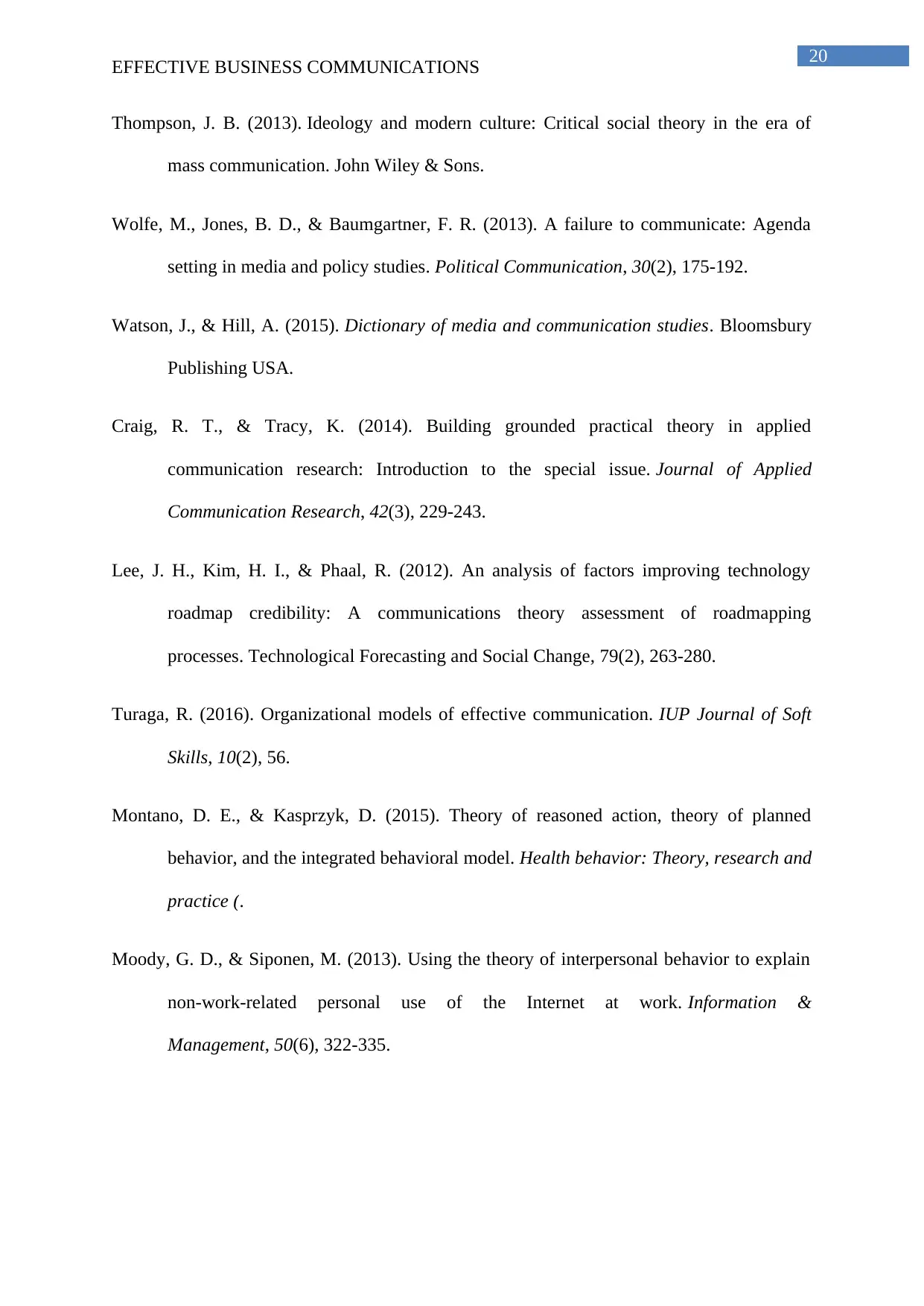
20
EFFECTIVE BUSINESS COMMUNICATIONS
Thompson, J. B. (2013). Ideology and modern culture: Critical social theory in the era of
mass communication. John Wiley & Sons.
Wolfe, M., Jones, B. D., & Baumgartner, F. R. (2013). A failure to communicate: Agenda
setting in media and policy studies. Political Communication, 30(2), 175-192.
Watson, J., & Hill, A. (2015). Dictionary of media and communication studies. Bloomsbury
Publishing USA.
Craig, R. T., & Tracy, K. (2014). Building grounded practical theory in applied
communication research: Introduction to the special issue. Journal of Applied
Communication Research, 42(3), 229-243.
Lee, J. H., Kim, H. I., & Phaal, R. (2012). An analysis of factors improving technology
roadmap credibility: A communications theory assessment of roadmapping
processes. Technological Forecasting and Social Change, 79(2), 263-280.
Turaga, R. (2016). Organizational models of effective communication. IUP Journal of Soft
Skills, 10(2), 56.
Montano, D. E., & Kasprzyk, D. (2015). Theory of reasoned action, theory of planned
behavior, and the integrated behavioral model. Health behavior: Theory, research and
practice (.
Moody, G. D., & Siponen, M. (2013). Using the theory of interpersonal behavior to explain
non-work-related personal use of the Internet at work. Information &
Management, 50(6), 322-335.
EFFECTIVE BUSINESS COMMUNICATIONS
Thompson, J. B. (2013). Ideology and modern culture: Critical social theory in the era of
mass communication. John Wiley & Sons.
Wolfe, M., Jones, B. D., & Baumgartner, F. R. (2013). A failure to communicate: Agenda
setting in media and policy studies. Political Communication, 30(2), 175-192.
Watson, J., & Hill, A. (2015). Dictionary of media and communication studies. Bloomsbury
Publishing USA.
Craig, R. T., & Tracy, K. (2014). Building grounded practical theory in applied
communication research: Introduction to the special issue. Journal of Applied
Communication Research, 42(3), 229-243.
Lee, J. H., Kim, H. I., & Phaal, R. (2012). An analysis of factors improving technology
roadmap credibility: A communications theory assessment of roadmapping
processes. Technological Forecasting and Social Change, 79(2), 263-280.
Turaga, R. (2016). Organizational models of effective communication. IUP Journal of Soft
Skills, 10(2), 56.
Montano, D. E., & Kasprzyk, D. (2015). Theory of reasoned action, theory of planned
behavior, and the integrated behavioral model. Health behavior: Theory, research and
practice (.
Moody, G. D., & Siponen, M. (2013). Using the theory of interpersonal behavior to explain
non-work-related personal use of the Internet at work. Information &
Management, 50(6), 322-335.
1 out of 21
Related Documents
Your All-in-One AI-Powered Toolkit for Academic Success.
+13062052269
info@desklib.com
Available 24*7 on WhatsApp / Email
![[object Object]](/_next/static/media/star-bottom.7253800d.svg)
Unlock your academic potential
© 2024 | Zucol Services PVT LTD | All rights reserved.





